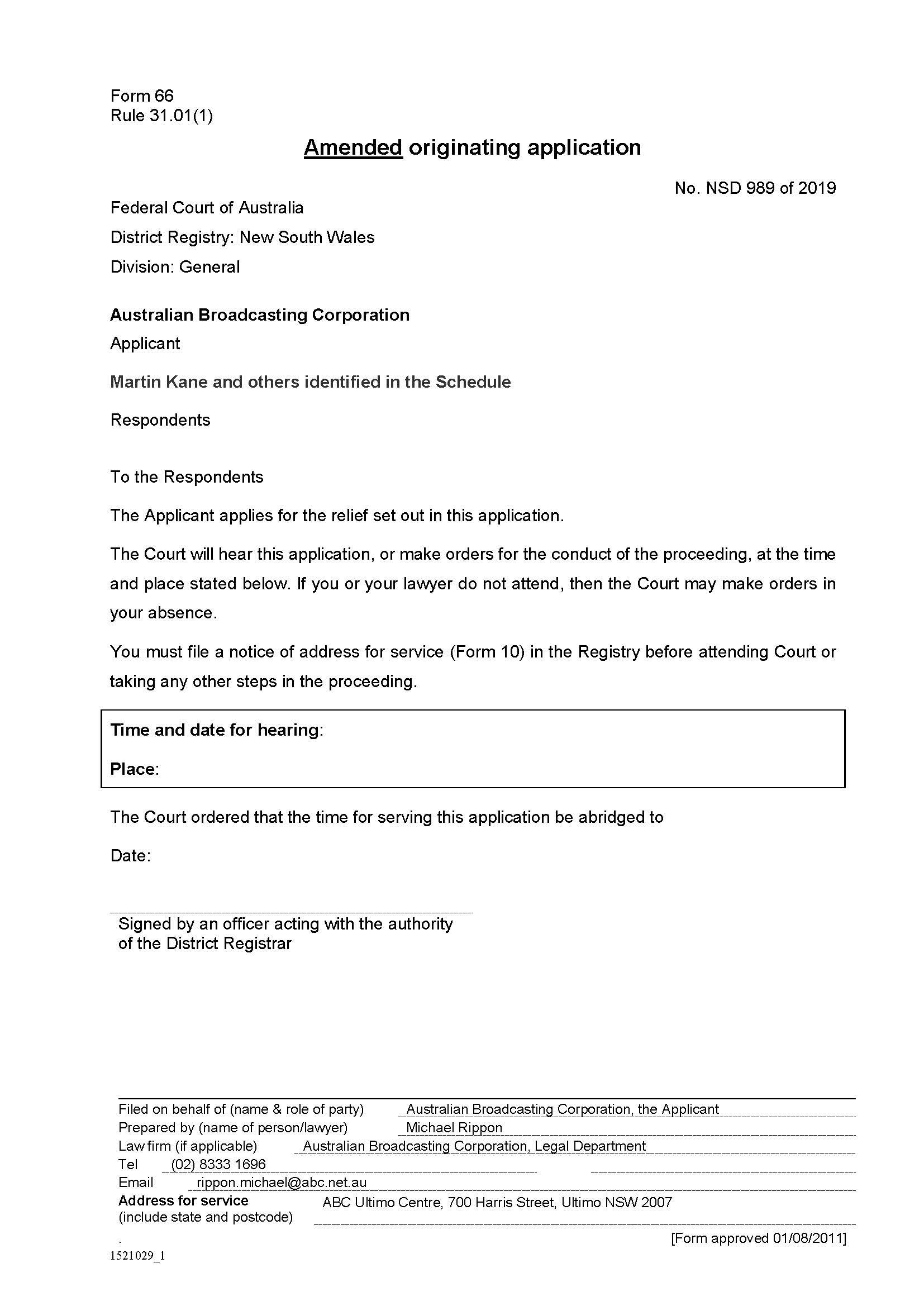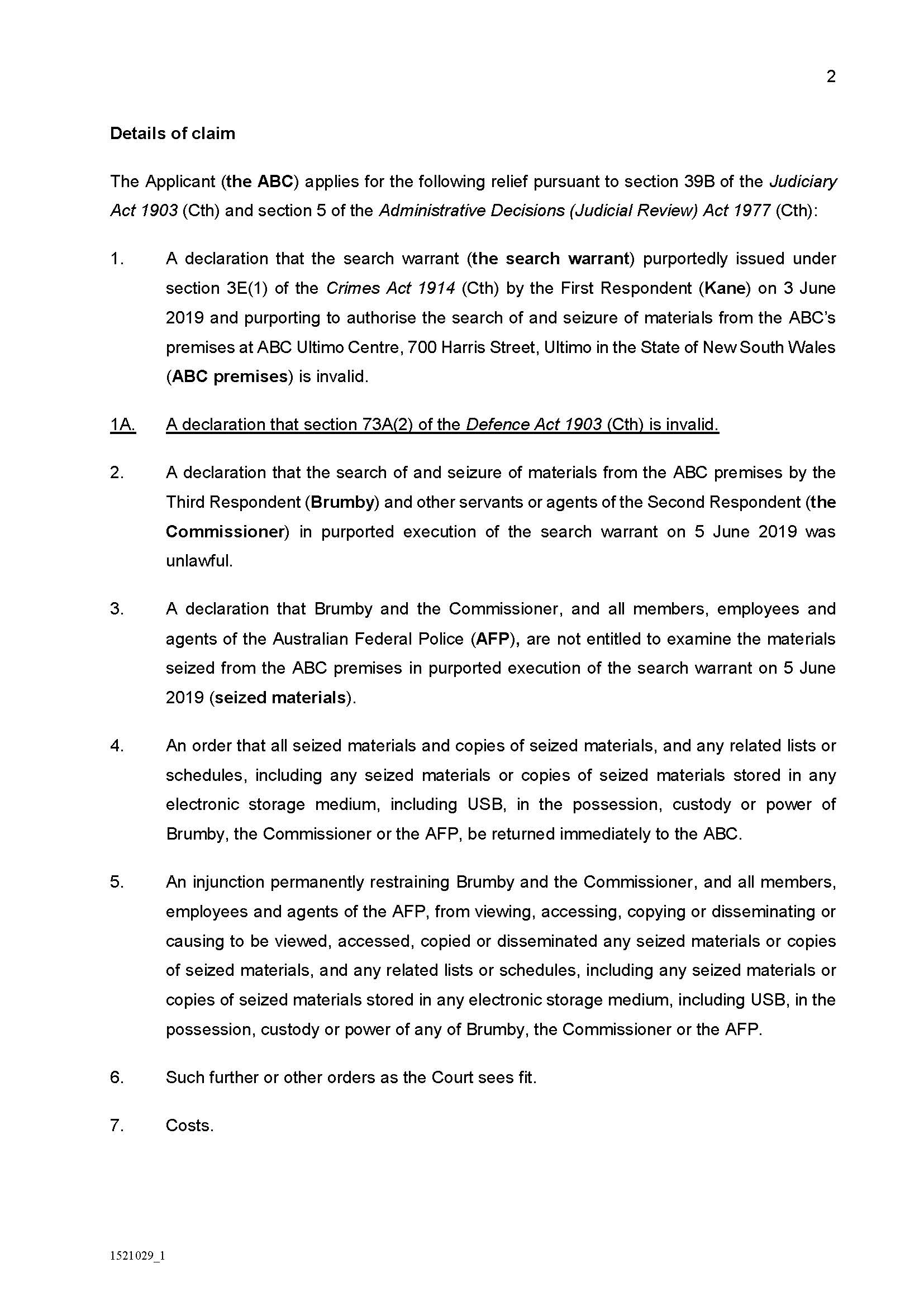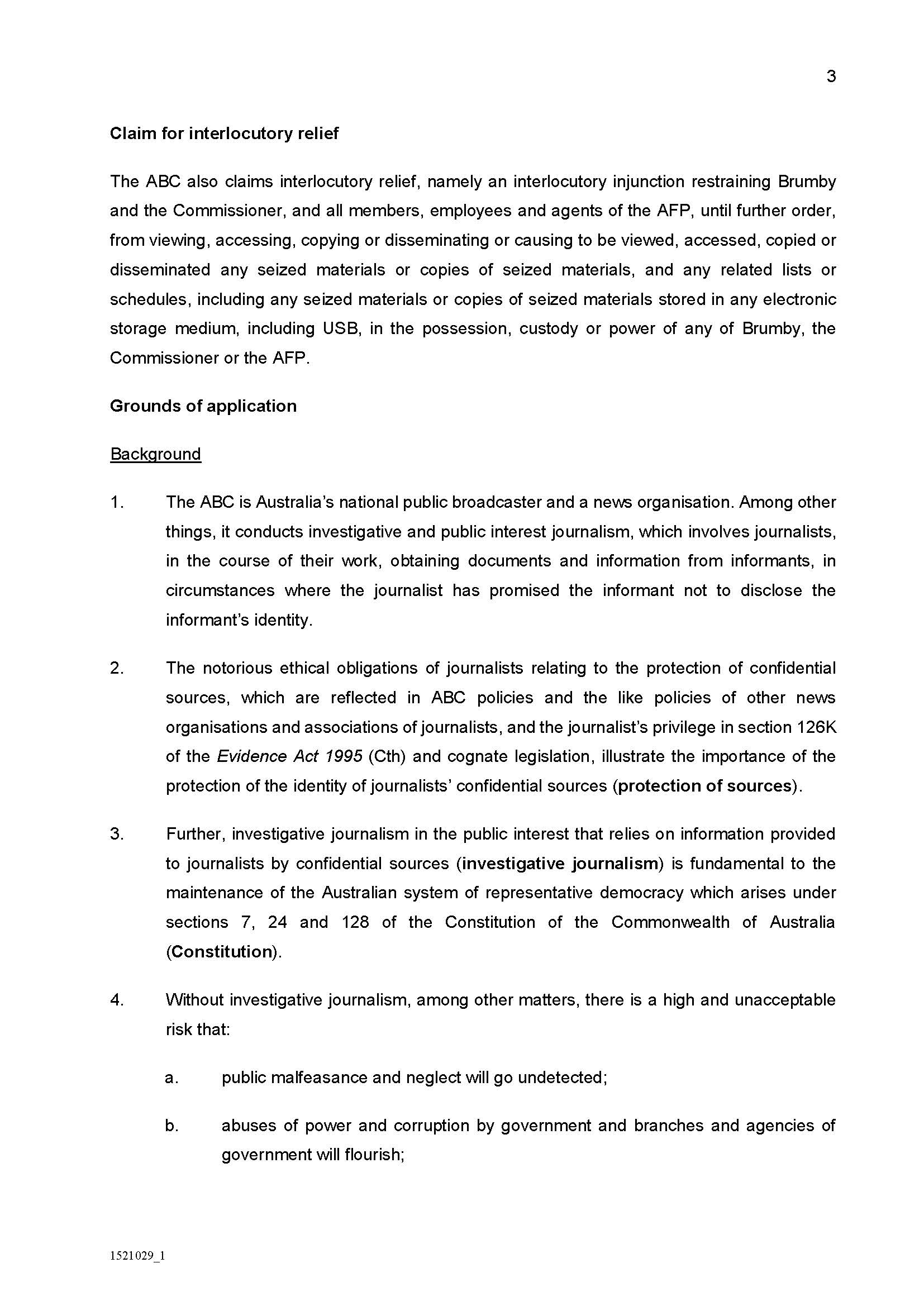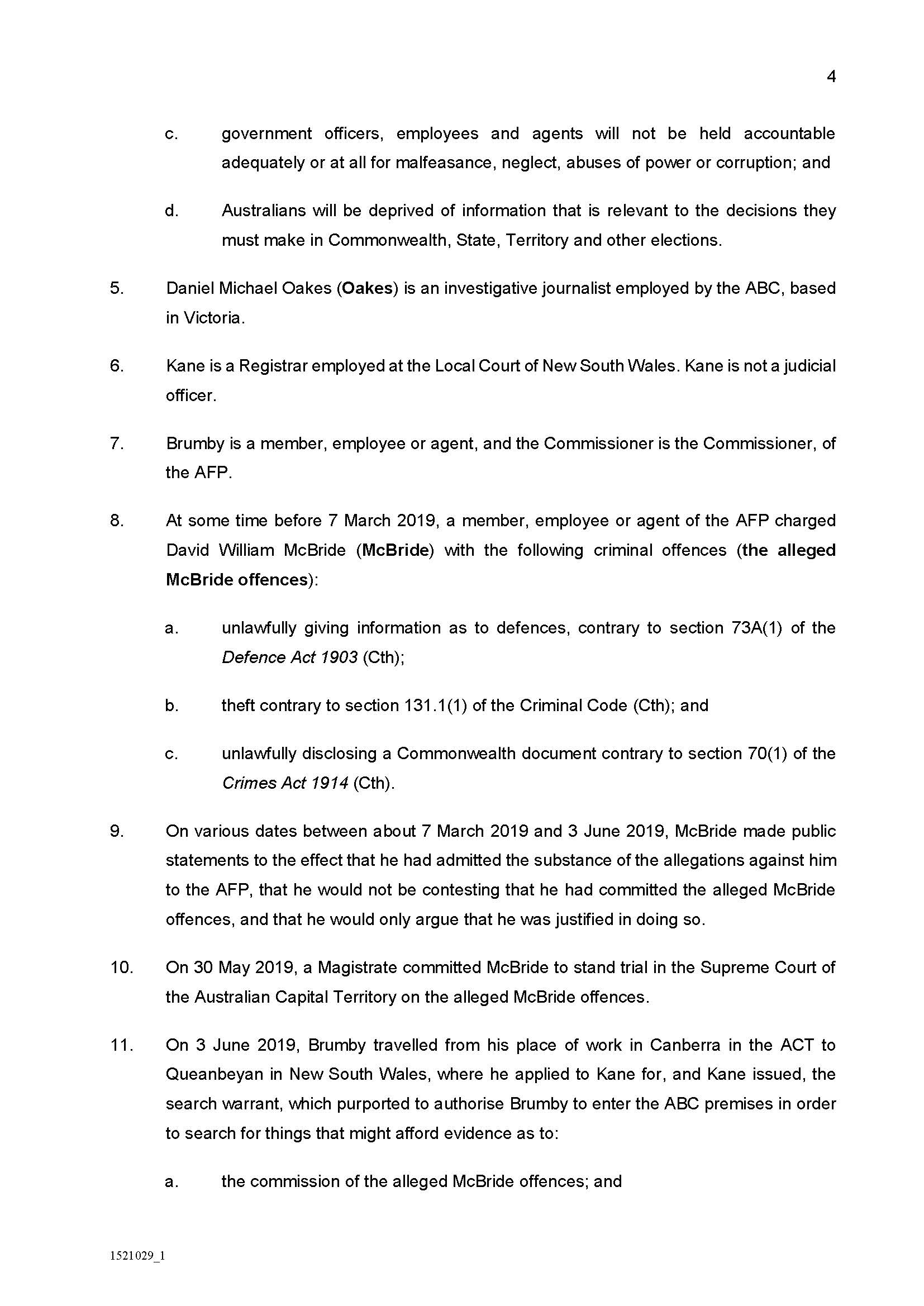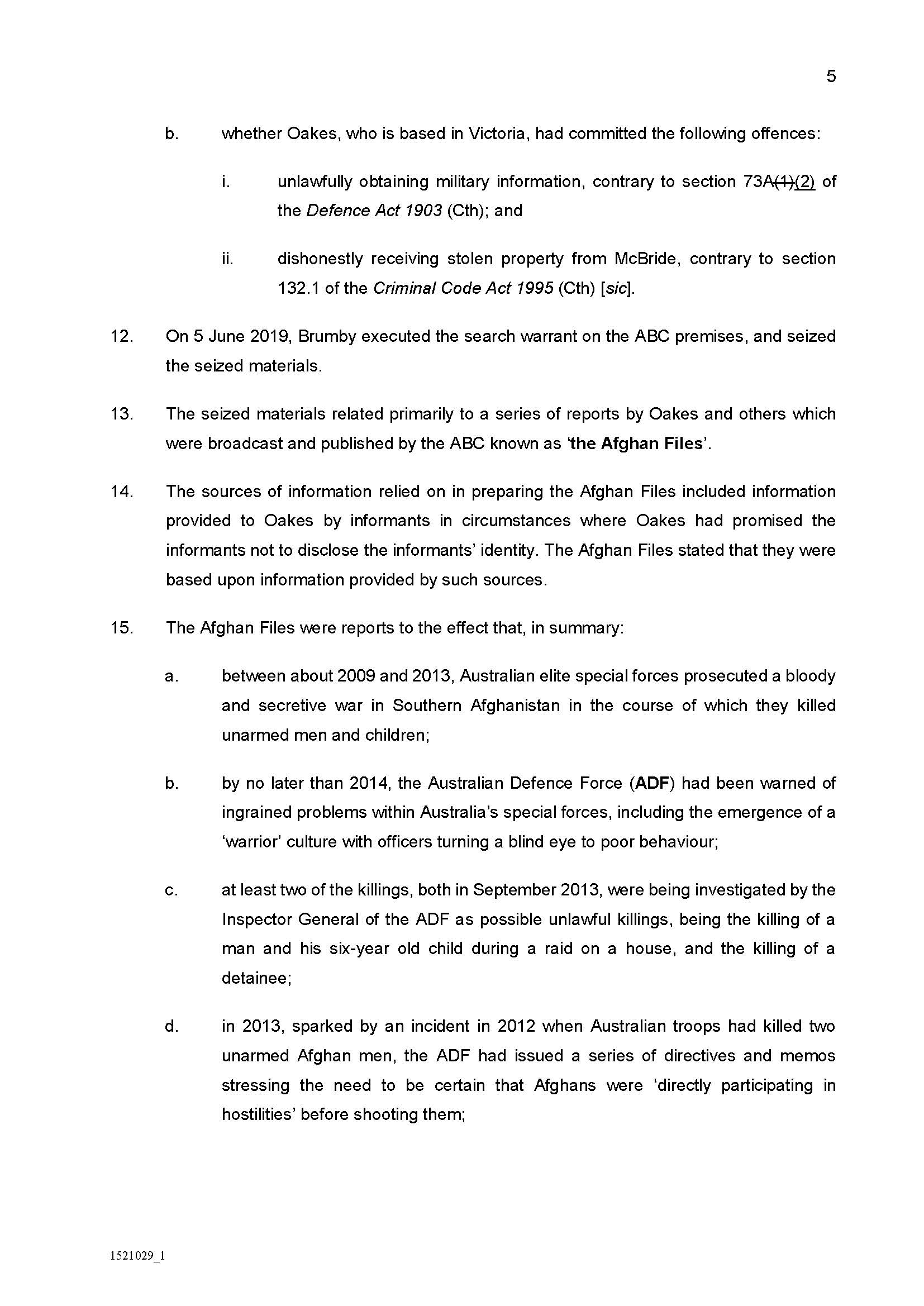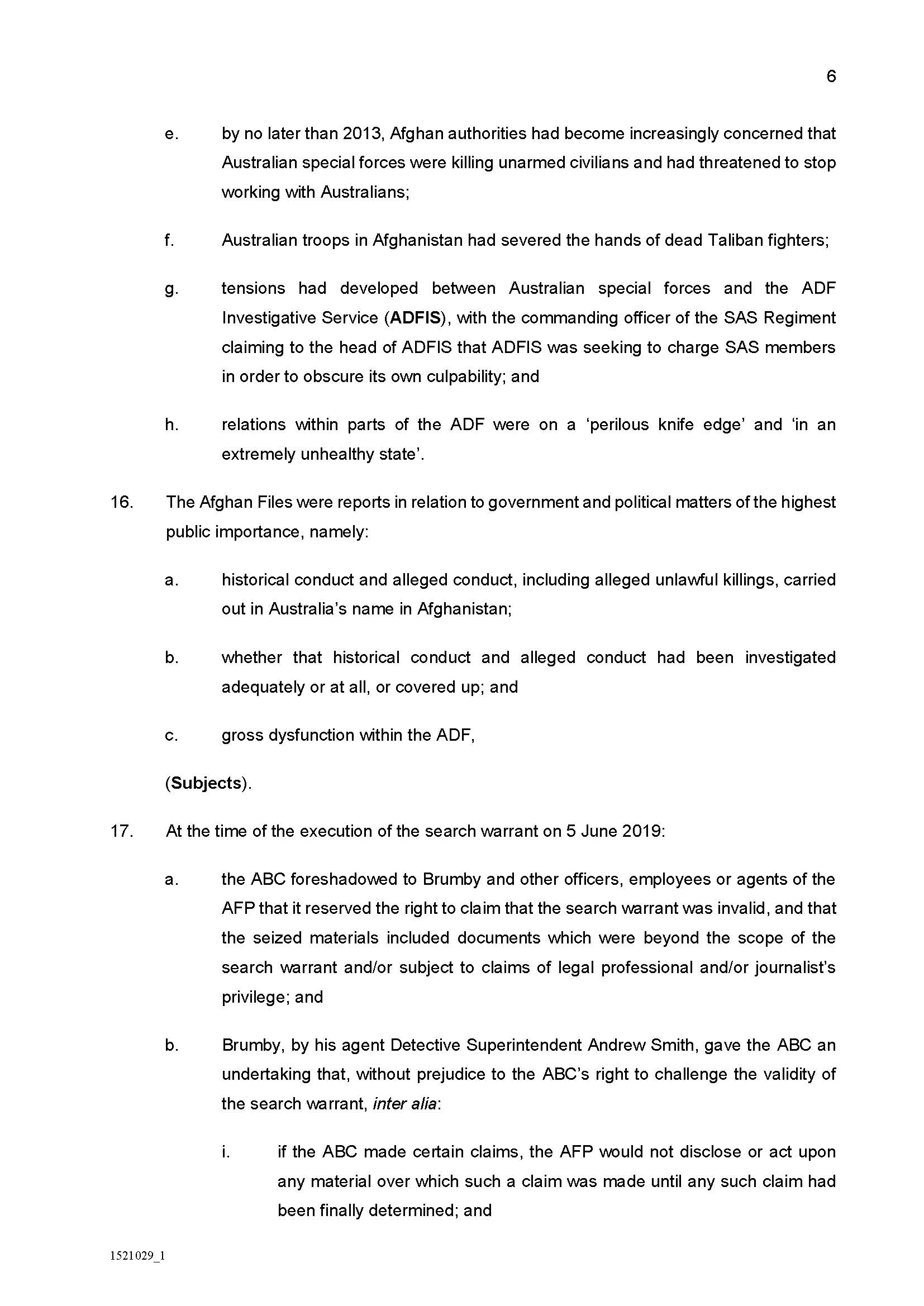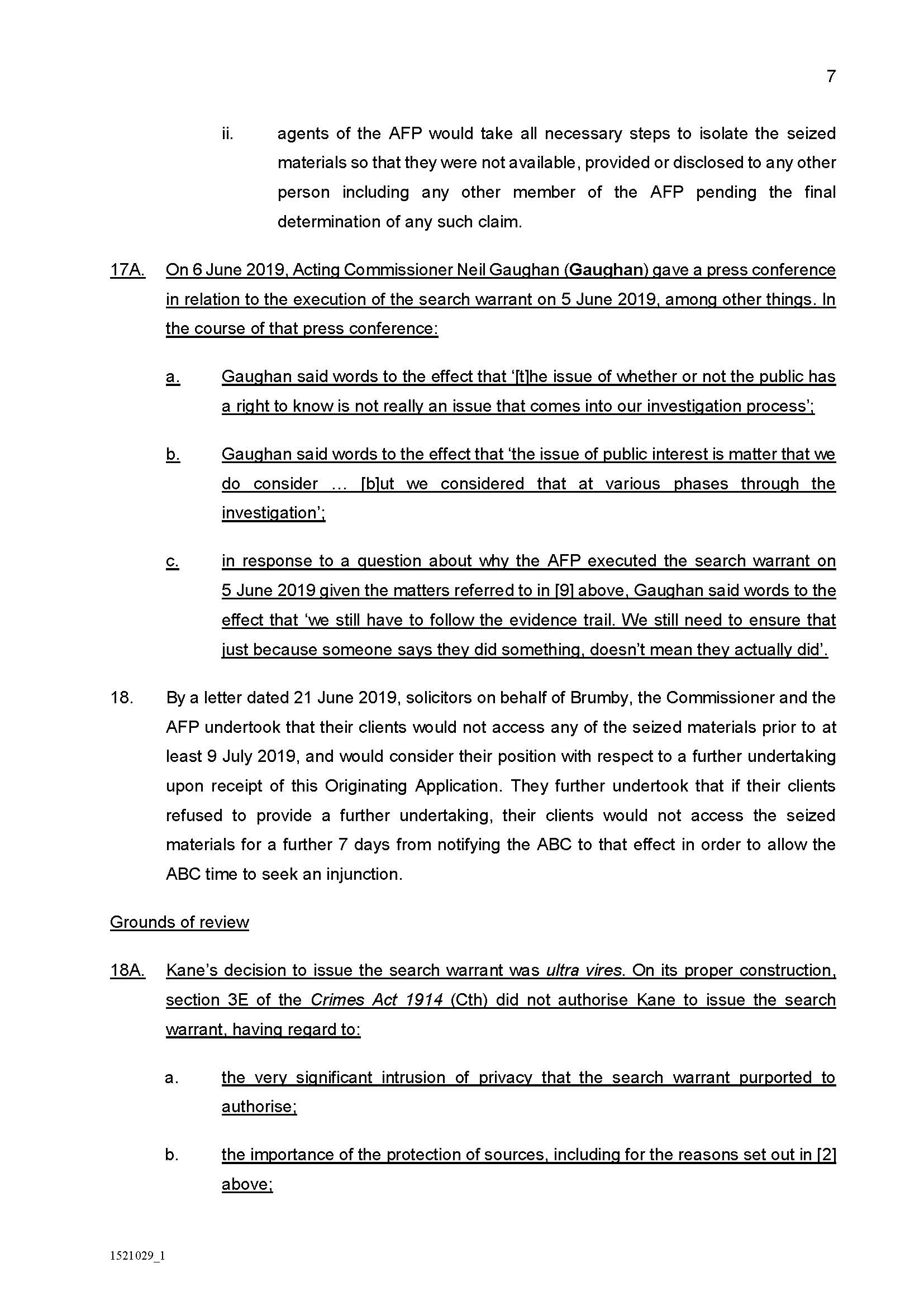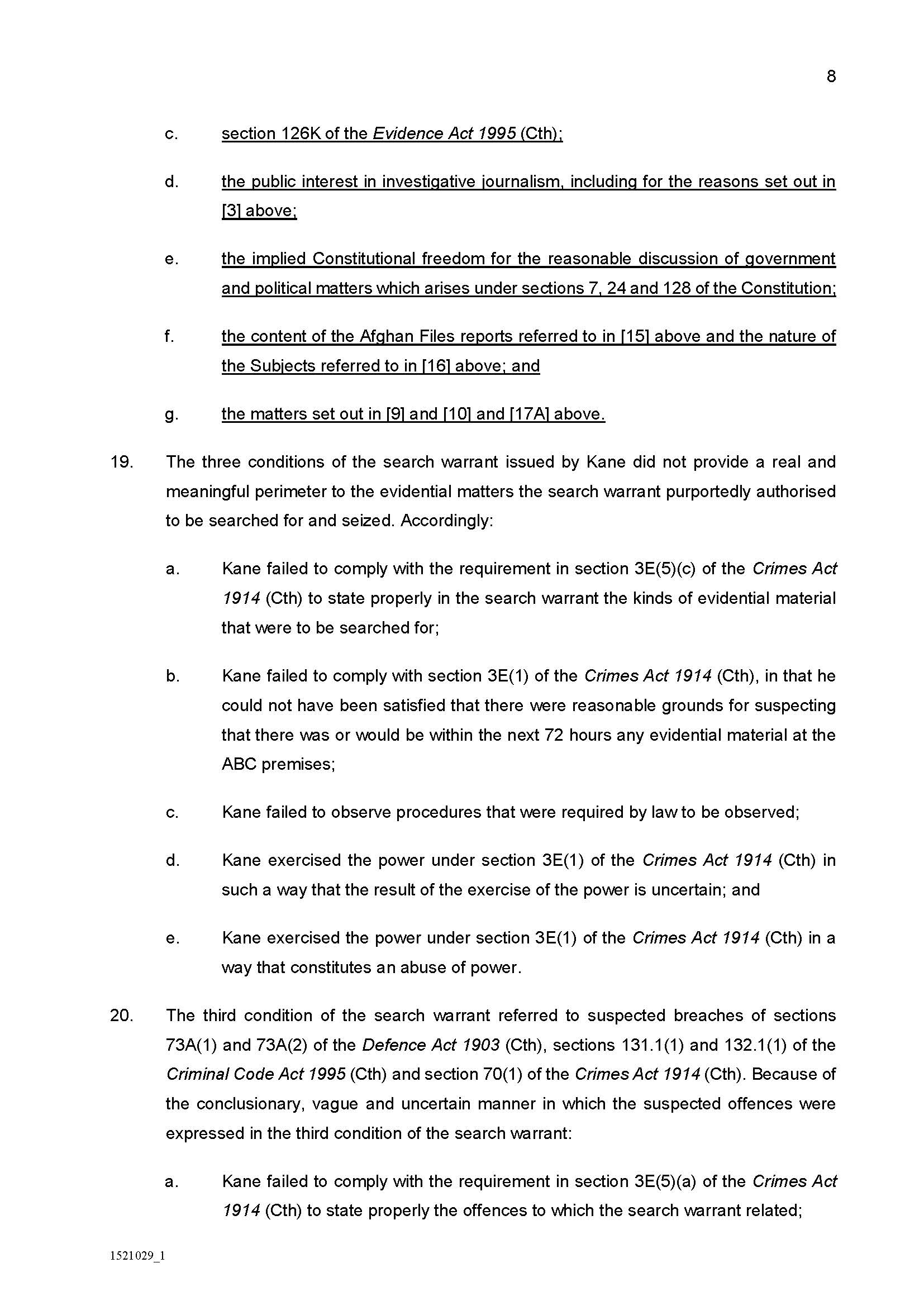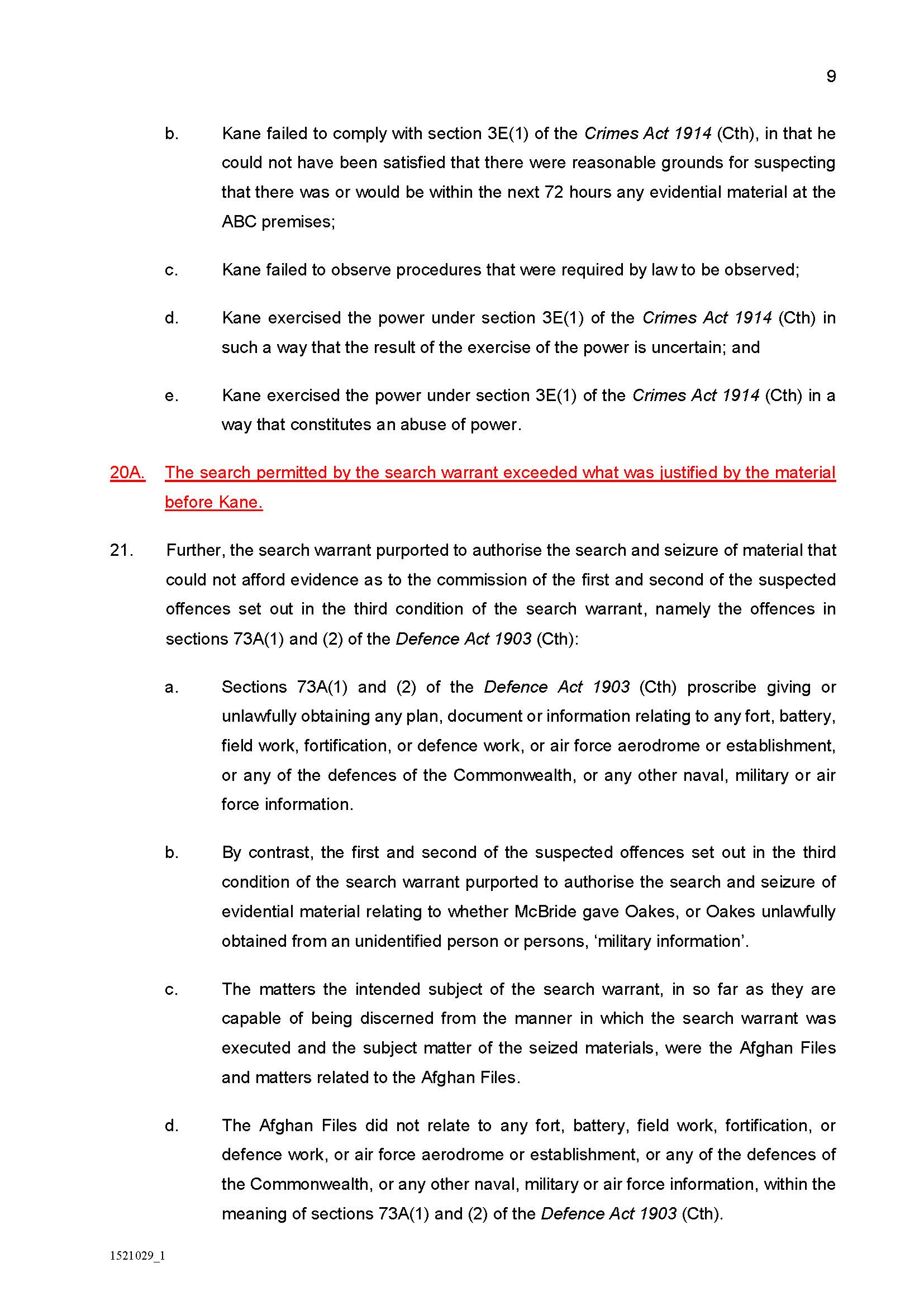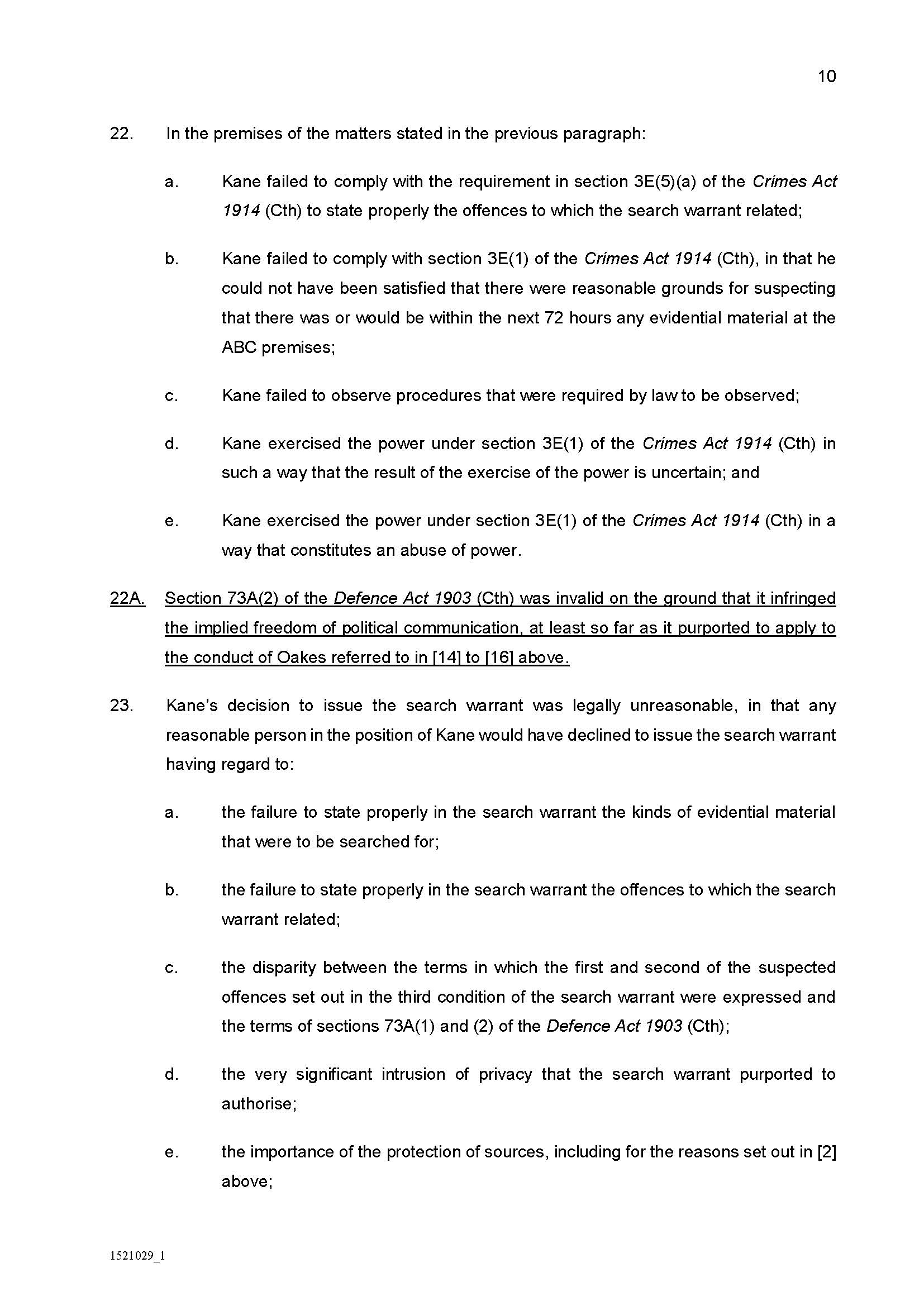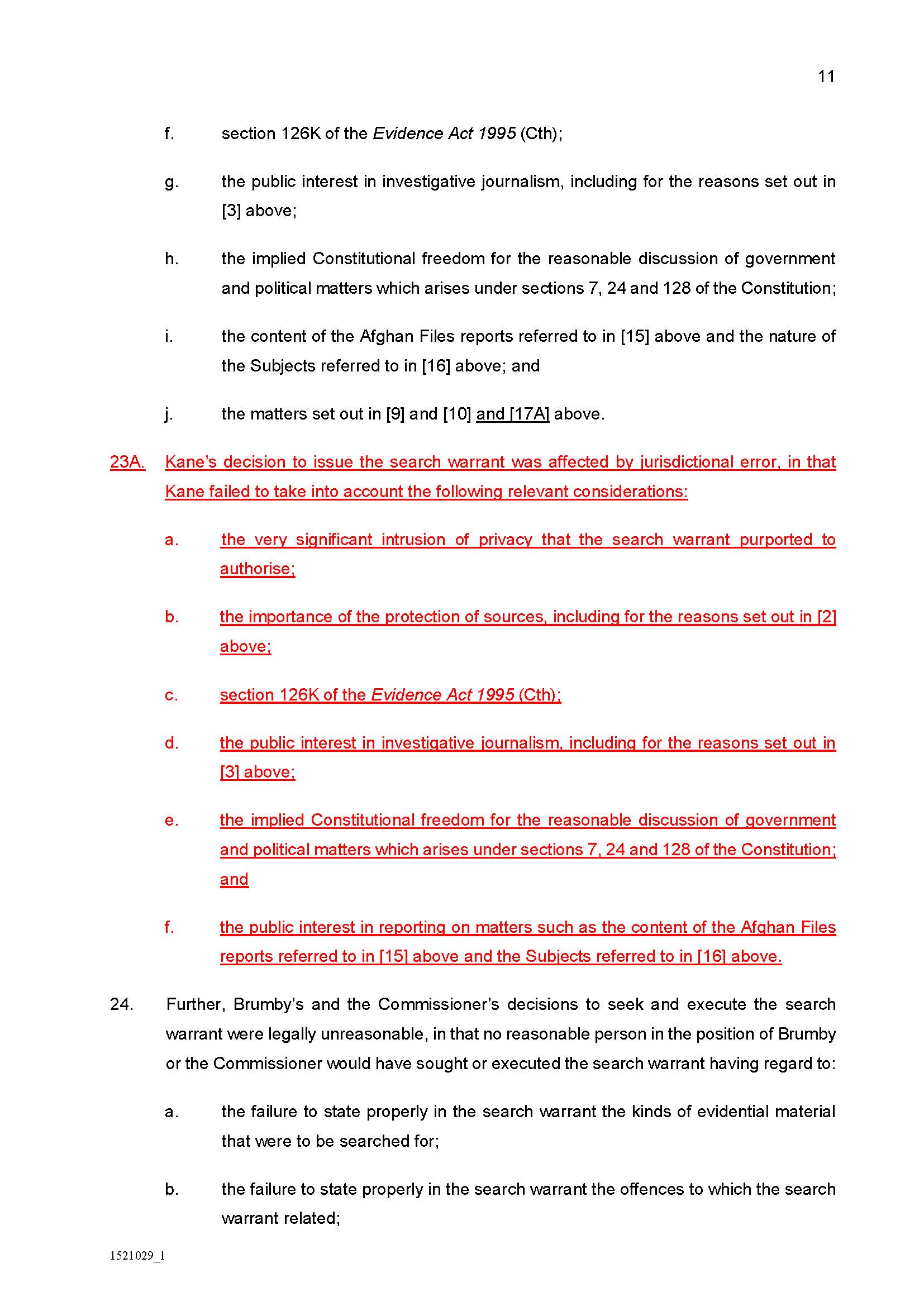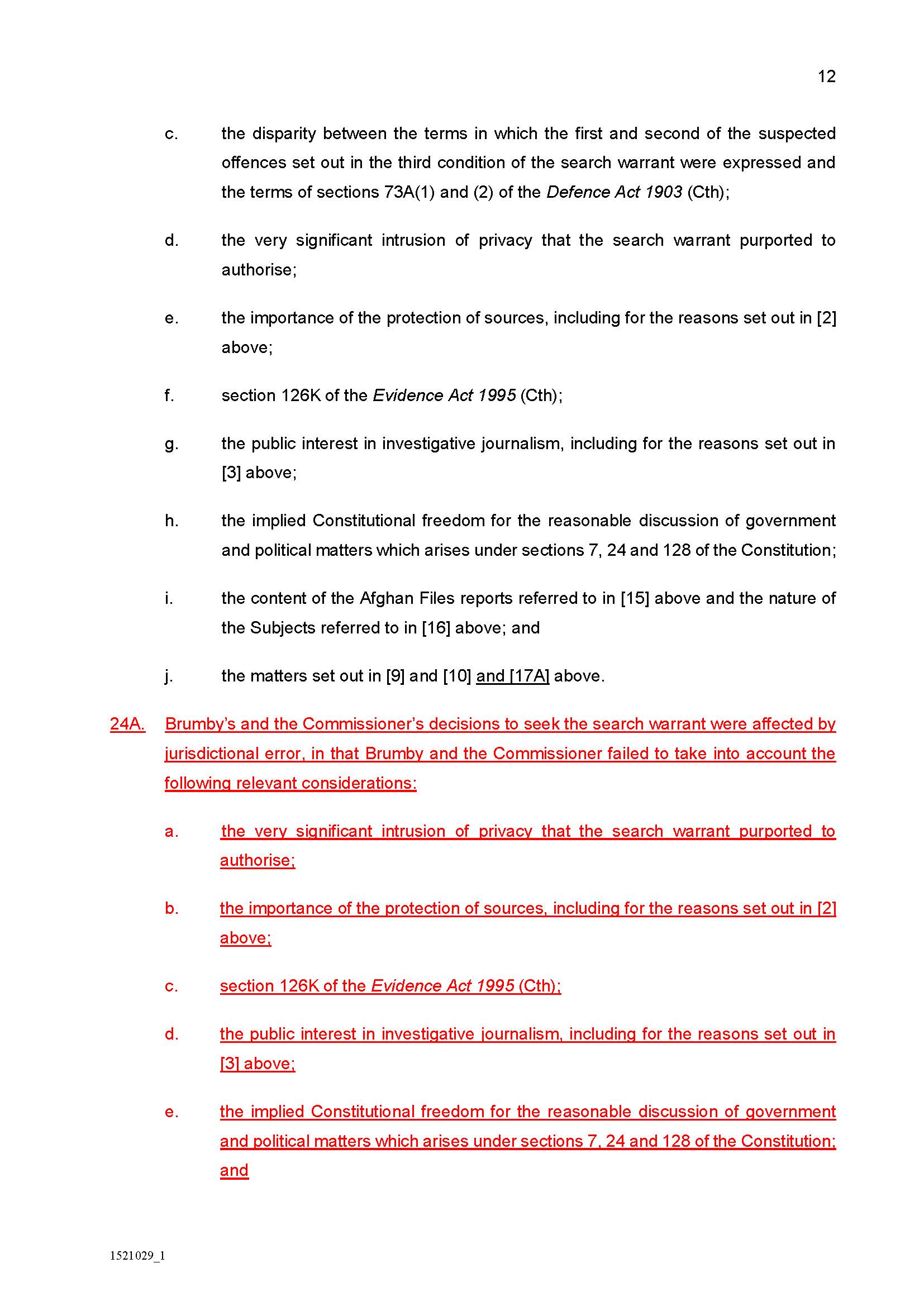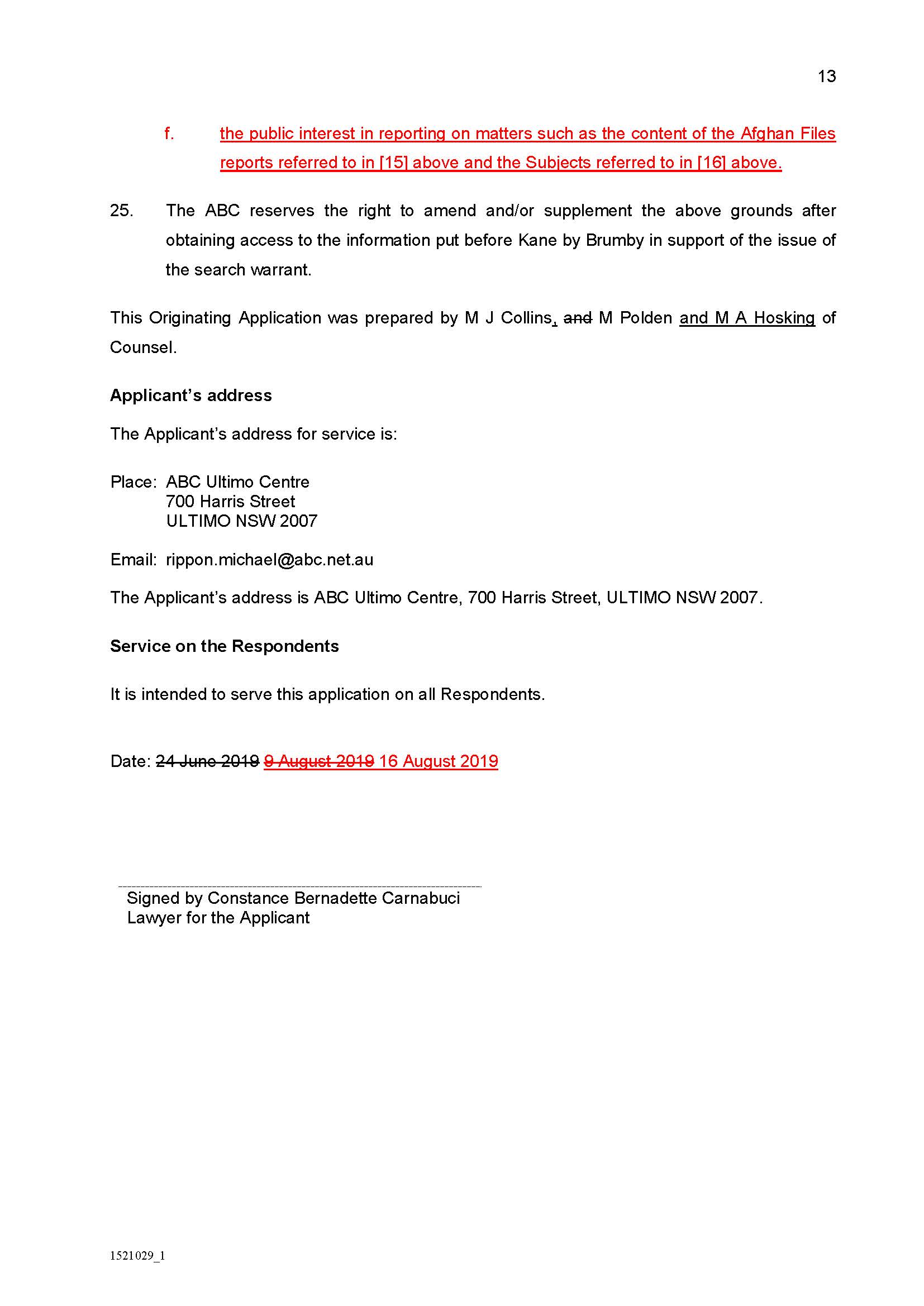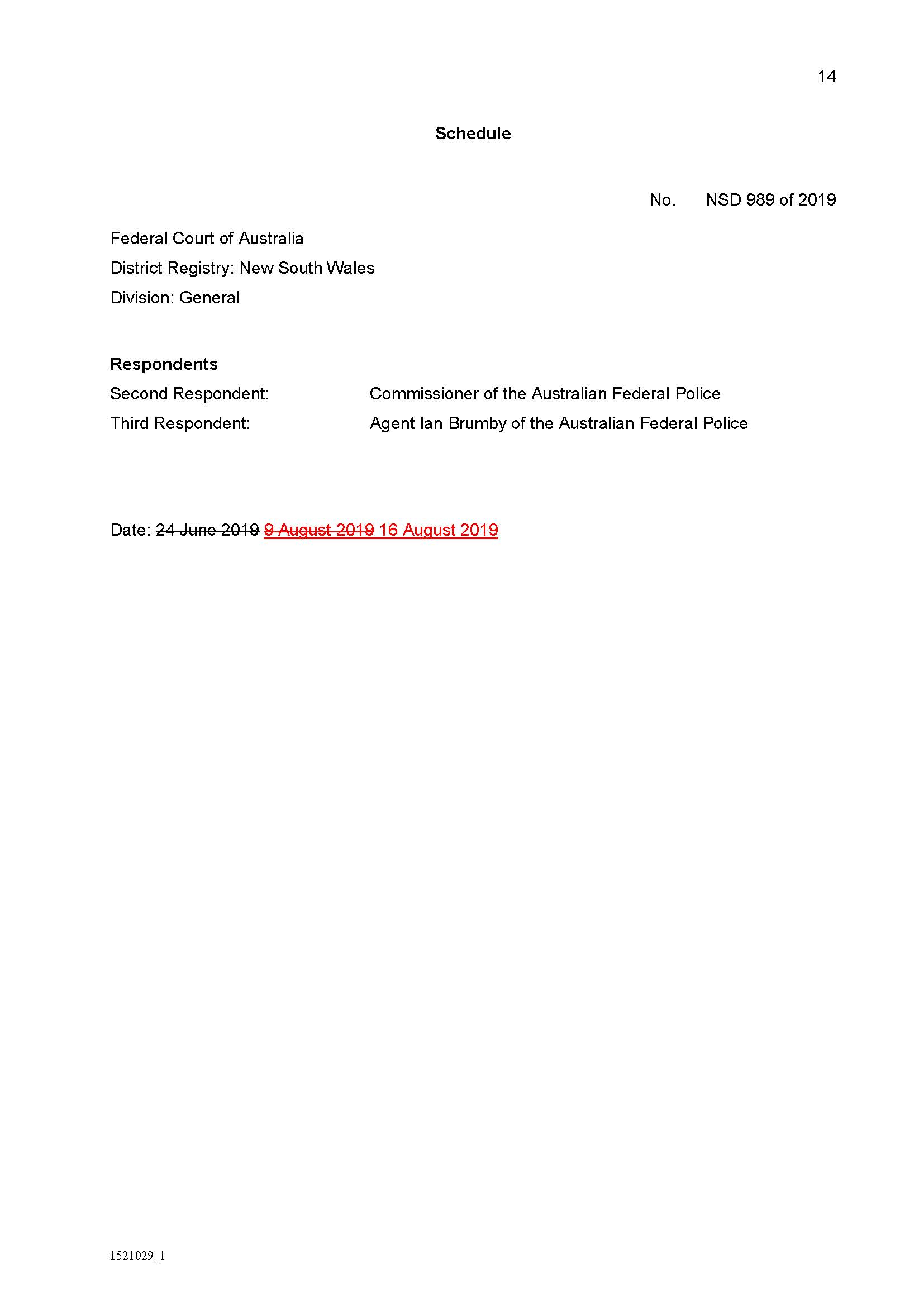Australian Broadcasting Corporation v Kane [2019] FCA 1312
ORDERS
AUSTRALIAN BROADCASTING CORPORATION Applicant | ||
AND: | First Respondent COMMISSIONER OF THE AUSTRALIAN FEDERAL POLICE Second Respondent AGENT IAN BRUMBY OF THE AUSTRALIAN FEDERAL POLICE Third Respondent | |
DATE OF ORDER: |
THE COURT ORDERS THAT:
1. The applicant’s application for leave to amend its originating application filed on 9 August 2019, be granted.
2. The applicant’s application for leave to amend the additional grounds of its originating application to add paragraphs 20A, 23A and 24A, filed on 16 August 2019, be refused.
3. The applicant’s Notice to Produce, dated 10 July 2019, be set aside.
4. The applicant’s application for an order under rules 20.13 and 20.15 of the Federal Court Rules 2011 (Cth) requiring the second and third respondents to give discovery of documents listed in its application dated 9 August 2019, as amended in the applicant’s reply submission dated 16 August 2019, be refused.
5. The cost of the applications to be reserved.
Note: Entry of orders is dealt with in Rule 39.32 of the Federal Court Rules 2011.
ABRAHAM J:
1 By its originating application dated 24 June 2019, the applicant, the Australian Broadcasting Corporation (ABC), challenges a warrant issued to the third respondent, Agent Ian Brumby, on 3 June 2019, pursuant to s 3E of the Crimes Act 1914 (Cth) (Crimes Act) (the warrant). The warrant authorised a search for certain material at the premises of the applicant. The warrant was executed on 5 June 2019.
2 This judgment addresses the applicant’s Notice to Produce and application for discovery in relation to these proceedings, which are contested by the second and third respondents.
Procedural history
3 It is appropriate to set out the relevant history of these proceedings.
4 On 10 July 2019, the applicant filed and served on the second and third respondents in the proceedings, the Commissioner of the Australian Federal Police (AFP) and Agent Ian Robert Brumby, a Notice to Produce seeking “[a] copy of any document, including any annexure, exhibit or attachment, and any other information comprising the information on oath referred to” in the warrant (Notice to Produce).
5 On 22 July 2019, the second respondent in the proceedings, filed and served on the applicant an interlocutory application seeking orders that the proceeding be expedited, and that the applicant’s Notice to Produce be set aside. In support of their interlocutory application, the second respondent relied upon an affidavit of Kristy Lee Alexander, affirmed on 22 July 2019, which addressed the application for expedition.
6 The applicant opposed the order for expedition. In support of its submission the applicant relied on an affidavit of Michael Antony Rippon, affirmed on 30 July 2019.
7 The hearing of those applications occurred on 2 August 2019, by which time (in compliance with orders of the Court) written submissions by each party had been filed.
8 The timetabling issues in relation to the hearing of the originating application were discussed at that hearing, and as a consequence, at least at this stage, the application for expedition does not need to be addressed. However, I observe that regardless of any order for expedition, it is axiomatic that proceedings of this nature (a challenge to the validity of the issue and execution of a search warrant) should ordinarily be dealt with as expeditiously as appropriately possible.
9 The decision on the application to set aside the applicant’s Notice to Produce was reserved.
10 At that hearing, the applicant requested, and an order was made, which enabled the applicant to file two applications: (1) to seek leave to amend its originating application; and (2) to obtain an order requiring the second and third respondents to give discovery. A timetable was set in relation to the filing of the relevant documents and the exchange of submissions by the parties in relation to the same. Any argument in relation to the proposed applications was listed for hearing on 19 August 2019.
11 Prior to those applications being filed, the Court made an inquiry with the parties as to whether any amendment that was proposed to be made to the originating application would affect the issues already argued in relation to the Notice to Produce. The Court was informed by the applicant that it would. As a result, the parties agreed to address any additional matters in their written submissions in relation to the application for discovery. In those circumstances, it was appropriate not to resolve the issue of the Notice to Produce until after the submissions had been made by both parties in respect to the application for discovery.
12 On 9 August 2019, the applicant filed an application for leave to amend the originating application together with a copy of the proposed amended originating application (first amended application), and an application for discovery. The applicant filed written submissions in support of the applications.
13 As foreshadowed, the applicant did make a further written submission in relation to the document sought in the Notice to Produce (addressed in relation to the application for discovery) although the submission did not address anything that had arisen out of any amendment to the originating application, but rather was a further, and additional submission, which addressed issues already raised, and argued, in the hearing of this matter. It is apparent from the applicant’s submission that the information sought by the Notice to Produce is also said to fall within the first category of documents sought by the discovery application.
14 On 14 August 2019, the second and third respondents filed written submissions addressing the applications. The respondents did not oppose the Court granting leave for the applicant to amend its originating application in the limited form proposed (in the first amended application). The respondents opposed the application for discovery.
15 On 16 August 2019, the applicant filed a reply submission and a further application to amend the originating application with a copy of the second proposed amended originating application (second amended application).
16 On 18 August 2019, the second and third respondents filed written submissions in reply to the second amended application, and opposed leave being granted to further amend the originating application.
Factual background
17 A basic chronology of uncontentious events, taken from the originating application and those affidavits filed by the parties, appears to be as follows.
18 On 11 July 2017, the ABC published various articles and programs concerning “The Afghan Files”. Those documents, which were said to include security classified documents, are described as the product of a “defence leak” in a story entitled “The Afghan Files” by ABC employees Daniel Michael Oakes and Sam Clark.
19 On 19 July 2017, the AFP commenced an investigation in connection with “The Afghan Files” story (AFP Investigation).
20 On 5 September 2018, David William McBride (McBride) was charged with theft contrary to s 131.1(1) of the Criminal Code Act 1995 (Cth) (Criminal Code), which is said to relate to this AFP Investigation.
21 On 13 September 2018, the AFP requested that three ABC employees participate in interviews or assist with the AFP Investigation, which they refused on 4 October 2018.
22 On 24 January 2019, the AFP contacted the ABC about the possibility of conducting a search of the ABC’s premises.
23 On 7 March 2019, McBride was charged with two further offences: unlawfully giving information as to defences, contrary to s 73A(1) of the Defence Act 1903 (Cth) (Defence Act), and unlawfully disclosing a Commonwealth document contrary to s 70(1) of the Crimes Act.
24 On 1 April 2019, the AFP requested that two ABC employees provide copies of their fingerprints and palm prints.
25 On 30 May 2019, McBride pleaded not guilty to the offences with which he is charged (as above at [20] and [23]) and on that day he was committed to stand trial in relation to those offences (the McBride Proceedings).
26 On 3 June 2019, Martin Kane (the first respondent) employed in the Local Court of New South Wales issued the warrant on the application of Agent Ian Brumby (the third respondent). The warrant authorised the third respondent to enter the ABC's premises in order to search for specified classes of things that might afford evidence as to McBride’s commission of the alleged offences, and whether Mr Oakes had committed the offences of unlawfully obtaining military information, contrary to s 73A(2) of the Defence Act, and dishonestly receiving stolen property from McBride, contrary to s 132.1 of the Criminal Code.
27 On 5 June 2019, Brumby executed the search warrant on the premises of the ABC and material was seized pursuant to that warrant.
28 On 24 June 2019, the ABC instituted proceedings in this Court, supported by an affidavit of Michael Antony Rippon affirmed 24 June 2019, applying for the following relief pursuant to s 39B of the Judiciary Act 1903 (Cth) and s 5 of the Administrative Decisions (Judicial Review) Act 1977 (Cth) as follows (as extracted from the applicant’s first amended application, with the applicant’s proposed amendments underlined, there being no further attempt to amend this aspect of the application):
1. A declaration that the search warrant (the search warrant) purportedly issued under section 3E(1) of the Crimes Act 1914 (Cth) by the First Respondent (Kane) on 3 June 2019 and purporting to authorise the search of and seizure of materials from the ABC’s premises at ABC Ultimo Centre, 700 Harris Street, Ultimo in the State of New South Wales (ABC premises) is invalid.
1A. A declaration that section 73A(2) of the Defence Act 1903 (Cth) is invalid.
2. A declaration that the search of and seizure of materials from the ABC premises by the Third Respondent (Brumby) and other servants or agents of the Second Respondent (the Commissioner) in purported execution of the search warrant on 5 June 2019 was unlawful.
3. A declaration that Brumby and the Commissioner, and all members, employees and agents of the Australian Federal Police (AFP), are not entitled to examine the materials seized from the ABC premises in purported execution of the search warrant on 5 June 2019 (seized materials).
4. An order that all seized materials and copies of seized materials, and any related lists or schedules, including any seized materials or copies of seized materials stored in any electronic storage medium, including USB, in the possession, custody or power of Brumby, the Commissioner or the AFP, be returned immediately to the ABC.
5. An injunction permanently restraining Brumby and the Commissioner, and all members, employees and agents of the AFP, from viewing, accessing, copying or disseminating or causing to be viewed, accessed, copied or disseminated any seized materials or copies of seized materials, and any related lists or schedules, including any seized materials or copies of seized materials stored in any electronic storage medium, including USB, in the possession, custody or power of any of Brumby, the Commissioner or the AFP.
6. Such further or other orders as the Court sees fit.
29 Following the execution of the warrant, a mutual undertaking was agreed to the effect that the AFP officers executing the warrant would not disclose or act upon any seized materials for a certain period of time to permit review of the seized documents by the ABC for the purpose of it making particular claims in relation to the documents (the Undertaking). While the parties disagree as to the meaning of the Undertaking, it is currently being complied with and at the lastest hearing of this matter, the parties have agreed to continue to do so at least until the conclusion of the substantive hearing in this matter, listed, at this stage, to commence on 28 October 2019 for two to three days.
30 Based on the affidavit material read by the applicant in the proceedings, between approximately 7 March 2019 and 18 July 2019, McBride has made various statements to, or reported in the media.
31 On 18 July 2019, in the McBride Proceedings, the Supreme Court ordered that the prosecution file an indictment, case statement, list of witnesses and trial questionnaire by 8 August 2019 and that McBride file his response by 15 August 2019. The matter is next in the Supreme Court for mention on 22 August 2019. Those proceedings are yet to be listed for trial.
Legal principles
32 It is convenient at the outset to address the relevant legal principles as they are applicable to both applications.
33 A Notice to Produce has the same coercive power as a subpoena duces tecum, and the principles governing the exercise of the Court’s power to set aside a Notice to Produce are the same as those which govern setting aside a subpoena for production issued to a party: Construction, Forestry, Mining and Energy Union v BHP Coal Pty Ltd (No 3) [2012] FCA 61 (CFMEU) at [5] per Collier J. The party who issued the Notice to Produce carries the onus of establishing that they are entitled to the documents sought: CFMEU at [6] per Collier J. Similarly, an applicant for an order for discovery also bears the onus of satisfying the Court that the documents sought are necessary: Alliance Craton Explorer Pty Ltd v Quasar Resources Pty Ltd (No 4) [2013] FCA 1044 at [33] per Mansfield J; Trade Practices Commission v CC (New South Wales) Pty Ltd (No 4) (1995) 58 FCR 426 at 436 per Lindgren J.
34 The parties accepted that the relevant principles applicable upon which discovery is ordered in judicial review applications are as summarised in Carmody v MacKellar [1996] FCA 791; (1996) 68 FCR 265 (Carmody) at 280 per Merkel J, as follows:
The following principles may now be taken to be well established by the decisions of the Court in Melbourne Home of Ford v Trade Practices Commission [1979] FCA 15; (1979) 36 FLR 450, W.A. Pines Pty Ltd v Bannerman [1980] FCA 79; (1980) 41 FLR 175 and Australian Securities Commission v Somerville (1994) 51 FCR 38:
• the Court has a discretionary power to order discovery in proceedings for the review of an administrative decision;
• the proper exercise of the power depends upon the nature of the case and the stage of the proceedings at which discovery is sought;
• if a proceeding or claims in it are essentially speculative in nature the Court will not order discovery in order to assist the applicant in a fishing exercise;
• the evidence or material which will be required to establish that the proceeding or particular claims in it are not essentially speculative will vary with the nature and circumstances of the particular case;
• if there is not the slightest evidence or there is no other material to support the bare allegations made in the proceeding, then as a general rule, an order for discovery ought not to be made.
35 These principles were accepted by the Full Court (Dowsett, Jacobson and Greenwood JJ) in Jilani v Wilhelm [2005] FCAFC 269; (2005) 148 FCR 255 (Jilani) at [108]. In that case, the Full Court observed that in Carmody, Merkel J recognised that the issue of a search warrant was an in camera exercise of executive power which should not be immunised from review by the imposition of unrealistic criteria for discovery: Jilani at [109]. The Full Court concluded that the answer to that conundrum raised by Merkel J about the undesirability of secrecy is, that the threshold may be lower in such cases but there must be some evidence or proper basis for suggesting that the warrant might have been issued unlawfully: Jilani at [109]; Carmody at 281.
36 The Full Court concluded that “it is not open to an applicant to make a bare allegation that a decision was made without any basis and then use the process of discovery to find out if the allegation has foundation”: Jilani at [111]. The Full Court continued, concluding that “[t]here must be sufficient definition of the issues to enable the Court to see that the documents sought on discovery relate to a live issue; there must at least be something from which the Court can see that there is a real issue the proof of which would be assisted by discovery”: Jilani at [112]. This requirement is applied “with some strictness in the law enforcement investigative context”: SMEC Holdings Pty Ltd v Commissioner of the Australian Federal Police [2018] FCA 609 (SMEC) at [25] per Bromwich J.
37 It is accepted that those principles referred to above apply equally to determining the application in relation to the Notice to Produce.
38 I note also that the Court will not make an order for discovery unless the making of the order will facilitate the just resolution of the proceeding as quickly, inexpensively and efficiently as possible: Federal Court Rules 2011 (Cth), r 20.11; Alanco Australia Pty Ltd v Higgins (No 2) [2011] FCA 1063 at [7] per McKerracher J.
Consideration
39 Given the history of these proceedings, it is necessary to first address the applicant’s second amended application, which is opposed by the respondents, before addressing the Notice to Produce and discovery application.
Second amended application
40 The applicant bears the onus of satisfying the Court that leave should be granted to file the further proposed amended application: Dye v Commonwealth Securities Ltd (No 2) [2010] FCAFC 118 at [17] per Marshall, Rares and Flick JJ. The relevant principles are summarised in Tamaya Resources Ltd (in liq) v Deloitte Touche Tohmatsu (A Firm), in the matter of Tamaya Resources Limited (in liq) [2015] FCA 1098 (Tamaya) at [125]–[128] per Gleeson J.
41 The applicant submitted that the arguments it is relying on are within the terms of the first amended application, and that the second amended application is made to avoid any confusion about the way in which the applicant puts its case. It was also submitted that the amendments were necessary to “avoid unnecessary and arid argument at the final hearing”.
42 The applicant submitted that the second amended application was the “final distillation” of the originating application, after matters had been crystallised by the exhange of submissions.
43 In relation to paragraph [20A] the applicant submitted that the sufficency of the material before the first respondent was always in issue as reflected by paragraph [20(b)] of the originating application. In relation to paragraphs [23A] and [24A] the applicant’s submission was that the issues raised in those grounds are the flipside of paragrpahs [23] and [24]. That is, there are two alternatives, either the decision is legally unreasonable (in paragraphs [23] and [24]) or the respondents failed to take into account the considerations specified.
44 When asked about the basis for paragraph [23A(1)], it became apparent that it is the fact that the warrant was sought and issued that is being relied on to support this ground. The applicant also relied on a passage in a media interview of Assistant Commissioner of the AFP after the day the warrant was executed to support its argument that the grounds were not speculative.
45 The respondents submitted that the basis of these amendments is not genuine, but reflects an impermissible attempt to obtain discovery.
46 The respondents detailed the history of this matter. The respondents pointed out that on 9 August 2019 the applicant filed and served an amended originating application (first amended application), and that neither that application, nor the original application of 24 June 2019, were filed in circumstances of urgency, and both were settled by Counsel and Senior Counsel. It was submitted that those documents may be taken to reflect the considered view of the applicant and its advisers of the grounds the applicant wished to advance in support of its challenge to the warrant.
47 The respondents submitted that in their written submission of 14 August 2019, they outlined why the applicant’s originating application, with the amendments proposed on 9 August 2019, did not entitle the applicant to the discovery it sought. The respondents submitted that the applicant’s reply submission and the second amended application implicitly accept the force of that submission. It is submitted that it is clear that the applicant has recognised that the documents sought are not relevant to the determination of the issues the applicant has raised and that the second amended application is an eleventh-hour attempt to reverse-engineer an application that would entitle the applicant to the documents it wants.
48 The respondents illustrated this by contrasting its submissons with the proposed further grounds of review, paragraphs [20A], [23A] and [24A]. The respondents submitted, contrary to the applicant’s submission, that the new grounds cannot be characterised as merely clarificatory or formal. Instead, the new grounds mirror precisely the claims that the second and third respondents’ submissions demonstrated had not been made.
49 The respondents refered to their written submission of 14 August 2019 in which they submitted that the applicant had put forward no ground of review alleging that “the search permitted by the search warrants (sic) exceeded what was justified by the material before the first respondent”, and that those are the terms now put forward in proposed paragraph [20A]. Similarly, the respondents identified they submitted in their submission of 14 August 2019 that the applicant had put forward no ground of review alleging that the respondents had failed “to take into account considerations that were required to be taken into account”, and that the proposed paragraphs [23A] and [24A] raise grounds of that exact kind.
50 The respondents submitted that the Court should readily draw the inference that the new grounds are being advanced solely for the impermissible purpose of bolstering the applicant’s discovery application. Where an application to amend is “really directed to meeting the difficulty of obtaining discovery of documents that the plaintiff may wish to see but which are not material to the case”, the Court should not regard the amendment application as genuine: Mulley v Manifold [1959] HCA 23; (1959) 103 CLR 341 (Mulley) at 349 per Menzies J.
51 The respondents submitted that the applicant has “engaged in a fishing expedition of the most transparent kind”. They submitted that the proposed grounds are, if anything, more speculative than those advanced in the applicant’s originating application and that in circumstances where a party makes allegations in a pleading based on suspicion, it is not entitled to discovery on those suspicions, for to do so is the clearest example of fishing by making a case where there is none: Austal Ships Pty Ltd v Incat Australia Pty Ltd (No 3) [2010] FCA 795; (2010) 272 ALR 177 (Austal Ships) at [10]; W.A. Pines Pty Ltd v Bannerman [1980] FCA 2; (1980) 41 FLR 169 at 173-174 per Toohey J; W.A. Pines Pty Ltd v Bannerman [1980] FCA 79; (1980) 41 FLR 175 at 181-182 per Brennan J, and 190-191 per Lockhart J.
52 The respondents submitted that neither the amendment, nor the documents sought in discovery, will facilitate the just resolution of the proceeding as quickly, inexpensively and efficiently as possible and both ought to be refused. Even if the Court were minded to permit the amendment, it should not order discovery in these circumstances, especially given the entirely speculative nature of the grounds. It was submitted there is no material to support the applicant’s suggestion that the first respondent, who authorised a search of the ABC’s premises for evidence relating to stories published by journalists, failed to consider “investigative journalism”. On this basis, the respondents content that the applicant is trawling.
53 The respondents submitted that the passages of the media interview relied on by the applicant do not have the interpretation contended for by the applicant. The respondents referred to other passages which they say more accurately reflect the statements made.
Consideration
54 In my view the respondents’ submission should be accepted.
55 The applicant’s submission that in effect the amendments make no difference, as the arguments it is relying on are within the terms of the first amended application such that it is entitled to the information and documents sought, is incorrect for reasons explained in more detail below (when considering the Notice to Produce and discovery application).
56 This application is in a context where there has already been argument in relation to the Notice to Produce, heard on 2 August 2019, during which the respondents raised some of these issues which the applicant now seeks to address by the new grounds. Plainly, careful consideration was given by the applicant to the terms of the originating application, and the first amended application. Given the timing of the second amended application and terms of the proposed new grounds [20A], [23A] and [24A], the compelling inference is that the amendments are being sought in order to address the clear issues, and problems for the applicant, raised by the respondents. In those circumstances the amendments sought “are really directed to meeting the difficulty of obtaining discovery of documents that the plaintiff may wish to see but which are not material to the case. In this sense, I do not regard the application to amend as a genuine application”: Mulley at 349 per Menzies J.
57 As is apparent from the reasoning below in relation to the Notice to Produce and the application for discovery, focus on the grounds pleaded is necessary to determine those issues. In the argument already on the Notice to Produce, it was apparent that the parties accepted this to be the case. As such, the issue is not one of confusion as to the meaning of the grounds as the applicant implies in its reply submission. Whether, as the applicant submits, its arguments are within the terms of the first amended application such as to entitle it to the information and documents sought , is addressed below. If the grounds are speculative, their inclusion to obtain discovery to determine if there is a basis for the grounds, is impermissible.
58 A consideration of the terms of the proposed grounds also reflects that they could not be genuine in the sense referred to in Mulley. For example, framing the proposed grounds [23A] and [24A] as a failure by the respondents to take into account at all, each of the public policy considerations which it considers are relevant considerations (including, for example, something as basic as the intrusion to privacy of a warrant), has no foundation other than the fact that the warrant was sought and issued. I note that the applicant’s written submission before this ground was added was that the respondents failed to take into account, or if they did, they failed to properly take into account those considerations. In any event, that the applicant might want to argue that none of the policy considerations were taken into account based on the fact that the warrant was sought and issued, does not provide a basis that would entitle the applicant to the documents sought by discovery. Nor, for reasons given below, does the applicant’s reliance on answers given in a media interview (see paragraphs [123] and [150]). Adding these grounds does not alter that. As the respondents submitted, this amounts to no more than a fishing expedition.
59 As explained in more detail below, paragraph [20A] is nothing more than a bare allegation, with no particulars identifying the basis for the allegation. If it is to be argued on the same basis as in ground 3, it is an argument premised on the submission that the warrant is vague, conclusionary and uncertain. As explained below, the argument in support of ground 3 as articulated, is an argument made on the face of the warrant.
60 I observe that when the Notice to Produce, which related to the information on oath and the sufficiency of that information, was argued, the applicant did not rely on ground 3 (in paragraph [20]) as the basis of the entitlement. Rather, only grounds 6 and 7, paragraphs [23] and [24], were relied on.
61 In Austal Ships at [10] McKerracher J observed:
In circumstances where a party makes allegations in a pleading based on suspicion, it is not entitled to interrogate on those suspicions, for to do so is the clearest example of fishing by making a case where none exists: WA Pines Pty Ltd v Bannerman [1980] FCA 2: (1980) 41 FLR 169 at 173-174 per Toohey J; WA Pines [1980] FCA 79; 41 FLR 175 at 181-182 per Brennan J; and 190-191 per Lockhart J. More recently see Minister for Immigration & Multicultural & Indigenous Affairs v Wong [2002] FCAFC 327 at [28]-[36]).
62 The applicant’s argument on these proposed grounds would be “nothing more than bootstrap reasoning, effectively presuming inadequacy in order to infer its existence”: SMEC at [28] per Bromwich J.
63 As noted above, the relevant principles in relation to an application to amend are summarised in Tamaya at [125]–[128] per Gleeson J.
64 In all the circumstances, leave to amend in the terms sought in the second amended application is refused. I note that if I had granted leave to amend in the terms of the second amended application the additional paragraphs would not have altered my conclusion in relation to the Notice to Produce or the application for discovery.
Notice to Produce
65 The Notice to Produce calls for the production of the information sworn on oath by the third respondent and provided to the first respondent in support of the application for the issue of the warrant (the Information Sought). The applicant contended that it can be inferred from the face of the warrant that that information was the sole basis upon which the first respondent was purportedly satisfied that there were reasonable grounds for suspecting that there was evidential material located at the applicant’s premises which met the criteria set out in all three conditions of the warrant.
66 When this matter was first argued, the applicant submitted that the Information Sought is relevant to its claims that the decisions of the second and third respondents to seek the warrant, and of the first respondent to issue the warrant, were legally unreasonable, referring only to paragraphs [23] and [24] of the originating application. That is, the Information Sought by the applicant is purportedly relevant to paragraphs [23] and [24] (referred to in the applicant’s further submissions as grounds 6 and 7), which are as follows:
23. Kane’s decision to issue the search warrant was legally unreasonable, in that any reasonable person in the position of Kane would have declined to issue the search warrant having regard to:
a. the failure to state properly in the search warrant the kinds of evidential material that were to be searched for;
b. the failure to state properly in the search warrant the offences to which the search warrant related;
c. the disparity between the terms in which the first and second of the suspected offences set out in the third condition of the search warrant were expressed and the terms of sections 73A(1) and (2) of the Defence Act 1903 (Cth);
d. the very significant intrusion of privacy that the search warrant purported to authorise;
e. the importance of the protection of sources, including for the reasons set out in [2] above;
f. section 126K of the Evidence Act 1995 (Cth);
g. the public interest in investigative journalism, including for the reasons set out in [3] above;
h. the implied Constitutional freedom for the reasonable discussion of government and political matters which arises under sections 7, 24 and 128 of the Constitution;
i. the content of the Afghan Files reports referred to in [15] above and the nature of the Subjects referred to in [16] above; and
j. the matters set out in [9] and [10] and [17A] above.
24. Further, Brumby’s and the Commissioner’s decisions to seek and execute the search warrant were legally unreasonable, in that no reasonable person in the position of Brumby or the Commissioner would have sought or executed the search warrant having regard to:
a. the failure to state properly in the search warrant the kinds of evidential material that were to be searched for;
b. the failure to state properly in the search warrant the offences to which the search warrant related;
c. the disparity between the terms in which the first and second of the suspected offences set out in the third condition of the search warrant were expressed and the terms of sections 73A(1) and (2) of the Defence Act 1903 (Cth);
d. the very significant intrusion of privacy that the search warrant purported to authorise;
e. the importance of the protection of sources, including for the reasons set out in [2] above;
f. section 126K of the Evidence Act 1995 (Cth);
g. the public interest in investigative journalism, including for the reasons set out in [3] above;
h. the implied Constitutional freedom for the reasonable discussion of government and political matters which arises under sections 7, 24 and 128 of the Constitution;
i. the content of the Afghan Files reports referred to in [15] above and the nature of the Subjects referred to in [16] above; and
j. the matters set out in [9] and [10] and [17A] above.
67 The underlined portion in each paragraph was added in the first amended application. That first amended application, and the second amended application with the applicant’s proposed amendments underlined, are attached to the judgment as Annexure A and Annexure B respectively.
68 As reflected in those paragraphs, the applicant submitted that no reasonable decision-maker in the position of the second and third respondents would have decided to seek the warrant, and no reasonable decision-maker in the position of the first respondent would have decided to issue the warrant, having regard to the matters which include: the very significant intrusion of privacy that the search warrant purported to authorise; the importance of the protection of journalists’ sources; the public interest in investigative journalism; and, the implied freedom of political communication. I note that while paragraph [24] refers to the respondents’ decisions to “seek and execute” the search warrant that latter aspect is not referred to by the applicant when describing this ground. Nonetheless, as reflected by the terms of the paragraph, it relates to the fact that the warrant was executed, it having been applied for and issued.
69 The applicant submitted that the Information Sought is relevant to these claims. The applicant contends that this information would demonstrate what matters were taken into account by the first respondent in deciding to issue the search warrant, and what matters were regarded as relevant by the second and third respondents in deciding to seek the warrant, which are said to be matters that are directly relevant to whether the decisions made by the respondents were legally unreasonable. It was submitted by the applicant that there is a real issue between the parties, the proof of which would be assisted by production of the Information Sought.
70 The applicant also contends that on the basis of the known facts, there is a proper basis for its contention that, in deciding to issue the search warrant, the first respondent made a decision that was legally unreasonable, and that those facts relevantly include that: the warrant was directed to a public broadcaster; the warrant sought evidence of communications between a putative source and journalists; the two journalists (who are identified in condition 2 of the warrant) are identified as the authors of the articles and a news story (broadcast on the ABC program, “7.30”) listed under condition 2 of the warrant; the articles themselves disclosed on their face that they were based on confidential sources; and the articles on their face concerned government and political matters of the highest public importance, namely alleged historical conduct and alleged conduct, including alleged unlawful killings carried out in Australia’s name in Afghanistan; whether that conduct had been investigated adequately or at all, or covered up; and gross dysfunction within the Australian Defence Force.
71 The applicant submitted that there is nothing in the materials to indicate that, in deciding to issue the warrant, the first respondent had regard to: the very significant intrusion of privacy that the warrant purported to authorise; the strong public policy interests in protecting confidential communications between journalists and their sources, and protecting the identity of those sources; or, the implied freedom of political communication which arises under ss 7, 24 and 128 of the Constitution, or whether issuing a warrant in the circumstances would be consistent with that freedom. The applicant contended that the known facts give rise to an inference that the first respondent purported to authorise very significant intrusions into fundamental rights without regard or any proper regard to any of these public policy interests. The applicant relies on the same argument in relation to the second and third respondent.
72 The applicant also submitted that the decisions of the respondents were legally unreasonable because of the disparity between the terms in which the first and second of the offences in the third condition of the warrant were expressed and the terms of ss 73A(1) and (2) of the Defence Act (referring to their originating application at [23(c)], [24(c)]). It was submitted by the applicant that there is a gulf between the manner in which the relevant suspected offences are expressed in the warrant (“military information”) and the terms of the offences themselves (“any plan, document or information relating to any fort, battery, field work, fortification, or defence work, or air force aerodrome or establishment, or any of the defences of the Commonwealth, or any other naval, military or air force information”) such that no reasonable decision-maker would have sought, or issued, a warrant containing such a disparity. The applicant contended that the proof of that claim would be assisted by production of the Information Sought.
73 The applicant’s oral submission was that as grounds 6 and 7 have been particularised in paragraphs [23] and [24] of the originating application (and therefore, are not bare allegations, nor have they been the subject of a strike out application or any suggestion that they are an abuse of process), the applicant is therefore entitled to the Information Sought, which might improve its claim as particularised in those paragraphs. The applicant submitted that there are many reasons why an administrative decision may be legally unreasonable.
74 As noted above, the second respondent seeks an order setting aside the Notice to Produce. The second respondent by way of written submissions made on behalf of both the second and third respondents, relies on two bases: first, that the originating application does not call into question the Information Sought; and second, in any event, disclosure of that material is unjustified.
75 The respondents initially submitted that none of the grounds specified in the originating application relate to the material relied on before the first respondent to support the issue of the warrant. After the applicant identified that it was paragraphs [23] and [24] of the originating application being relied upon (now referred to as grounds 6 and 7) the respondents submitted that the Information Sought could only possibly be relevant to the claim in ground 6 which relates to the issue of the warrant, although they further submitted that the claim of legal unreasonableness as particularised in this paragraph falls to be determined on the face of the warrant only, such that the Information Sought would not assist that claim. The respondents submitted that the Information Sought is irrelevant to the claim in ground 7 that seeking and executing the warrant was legally unreasonable.
76 The respondents submitted that the applicant contends that any reasonable decision-maker would consider the matters at [23(d), (e), (g) and (h)] to be decisive considerations against the issue of the warrant. The respondents submitted that if the first respondent was legally bound to treat those factors as decisive, as the applicant contends, the applicant’s argument will succeed and that the terms of the material before the issuing officer are irrelevant to that contention.
77 In relation to the first particular relied upon at [23(d)], “the very significant intrusion of privacy”, the respondents submitted that search warrants, by their very nature, involve a significant intrusion of privacy. Therefore, the respondents contend that that intrusion does not make the issue of a warrant legally unreasonable. The respondents contended that the second particular, “the importance of the protection of sources”, can have very limited significance where the applicant’s evidence demonstrates that McBride, has publicly identified himself. In relation to the third particular, “the public interest in investigative journalism”, the respondents submitted that this issue arises in relation to any application for a search warrant authorising a search of premises belonging to a media organisation and such consideration does not make the issue of a warrant legally unreasonable. To the extent it is relevant to the issue of a warrant (which is not conceded), the respondents submitted that similar to the arguments made in relation to the third particular, the applicant’s fourth particular, “the implied freedom of political communication”, could potentially arise in relation to any application for a search warrant authorising a search of premises belonging to a media organisation.
78 The respondents submitted that the applicant has not identified, beyond a bare assertion, how the Information Sought is relevant to these particulars. The applicant has not alleged any general or specific deficiency in the Information Sought that could render the issue of the warrant invalid.
79 The respondents submitted that the effect of the applicant’s submission if correct, would be that any allegation of legal unreasonableness in relation to the issue of a warrant, however speculative, would entitle an applicant to all material that was before the issuing officer.
80 As to the purported disparity in relation to the terms of the warrant and the terms of the s 73A offence under the Defence Act, the respondents submitted that the term used in the warrant, “military information”, exactly mirrors the terms of the relevant offences, which, among other matters, apply to “any other naval, military or air force information”. In any case, the respondents contend that this alleged defect in the warrant arises, if it exists, on the face of the warrant, and can be determined on the face of the warrant alone. Therefore, it is the respondents’ contention that the submission by the applicant that the Information Sought will assist its claim, is pure speculation.
81 The respondents addressed the legal principles, and in doing so emphasised that in Carmody at 280, Merkel J said that “if there is not the slightest evidence or there is no other material to support the bare allegations made in the proceeding, then as a general rule, an order for discovery ought not to be made”. The respondents submitted that this case falls into the same category as the discovery application in SMEC.
82 The respondents submitted that the recitation of the factual context for the warrant does not provide a basis, or evidence, for suggesting that the warrant might have been issued unlawfully. The respondents submitted that the particulars in paragraphs [23] and [24] forming the basis of grounds 6 and 7, referred to above, meet Bromwich J’s description in SMEC (at [28]) of “largely stating the obvious in the abstract”.
83 The respondents submitted that in any event, disclosure is not appropriate in circumstances where any alleged defect in the Information Sought is essentially speculative. The respondents submitted that the courts have held that there must be a basis, supported by at least some evidence, for suggesting that the warrant might have been issued unlawfully and that it is not open to the applicant to make a bare allegation that the decision to issue the warrant was made without any basis, and subsequently issue a Notice to Produce in an attempt to provide a foundation for that allegation. The applicant must establish the existence of a real issue concerning the validity of the warrant and the Court can then assess whether discovery would be appropriate considering that issue. In support of those contentions the respondents relied on the principles in Carmody at 280. The respondents submitted that any allegation in this case is essentially speculative, and the general rule against discovery should apply such that the applicant’s Notice to Produce should be set aside. It was submitted that the grounds raised by the applicant can be properly assessed by reference to the warrant itself. Even if the warrant is found to be invalid on its face, that also would not, without more, support any inference that the supporting material was insufficient.
84 The applicant submitted that the respondents’ contentions should be rejected.
85 As noted above, in the further written submission filed in relation to the discovery application after the initial hearing of this application, the applicant raised a new argument in relation to the Information Sought, namely, that by the time the application for the warrant was made the AFP would have known with particularity which documents they sought, and as the conditions of the warrant are purportedly “vague, general and conclusory”, there is basis to infer that the search permitted by the three conditions of the warrant exceeded what was necessary to achieve the warrant’s purpose. The applicant submitted that this argument raised the issue of the sufficiency of the information on oath to which it claims it is entitled. This argument relates to paragraph [20] (referred to in the applicant’s further submissions as ground 3) of the originating application. This ground was not the subject of any amendment (in either the first or second amended application), and was in this form in the original originating application. Paragraph [20] is as follows:
20. The third condition of the search warrant referred to suspected breaches of sections 73A(1) and 73A(2) of the Defence Act 1903 (Cth), sections 131.1(1) and 132.1(1) of the Criminal Code Act 1995 (Cth) and section 70(1) of the Crimes Act 1914 (Cth). Because of the conclusionary, vague and uncertain manner in which the suspected offences were expressed in the third condition of the search warrant:
a. Kane failed to comply with the requirement in section 3E(5)(a) of the Crimes Act 1914 (Cth) to state properly the offences to which the search warrant related;
b. Kane failed to comply with section 3E(1) of the Crimes Act 1914 (Cth), in that he could not have been satisfied that there were reasonable grounds for suspecting that there was or would be within the next 72 hours any evidential material at the ABC premises;
c. Kane failed to observe procedures that were required by law to be observed;
d. Kane exercised the power under section 3E(1) of the Crimes Act 1914 (Cth) in such a way that the result of the exercise of the power is uncertain; and
e. Kane exercised the power under section 3E(1) of the Crimes Act 1914 (Cth) in a way that constitutes an abuse of power.
86 The respondents submitted that the fundamental problem with the applicant’s argument is that the allegation in ground 3 makes no reference to the material that was before the first respondent at the time the warrant was issued, nor is there any allegation that such material was insufficient. It was submitted by the respondents that this ground is entirely concerned with consequences said to flow from the “conclusionary, vague and uncertain” articulation of the relevant offences in the warrant itself, and that there is no other ground of review elsewhere put forward by the applicant which alleges that “the search permitted by the search warrants (sic) exceeded what was justified by the material before the first respondent”.
87 In the second amended application, paragraphs [20A], [23A] and [24A] were added. The terms of those paragraphs are included at Annexure B to this judgment.
Consideration
88 When this matter was first argued the applicant contended that because the Information Sought is relevant only to what is now grounds 6 and 7, the issue of whether the Notice to Produce should be set aside is to be considered by reference to what is alleged in those grounds. As noted above, after the decision was reserved the applicant put forward a further and additional argument, referred to by the applicant as ground 3, which relates to paragraph [20] of the originating application.
89 For the following reasons, the Notice to Produce ought to be set aside.
Grounds 6 and 7
90 I will address the bases separately, dealing first with grounds 6 and 7 and the arguments that were initially advanced by the applicant.
91 First, it is clear that the applicant’s challenge to the warrant on the grounds of legal unreasonableness is based on the fact that the warrant was sought and issued. It submits that no reasonable decision-maker in the position of the second and third respondents would have decided to seek the warrant, and no reasonable decision-maker in the position of the first respondent would have decided to issue the warrant, having regard to the matters which include: the very significant intrusion of privacy that the search warrant purported to authorise; the importance of the protection of sources; the public interest in investigative journalism; and the implied freedom of political communication. These, as the applicant describes them, are “public policy” considerations. As is apparent from the applicant’s written submission, those considerations are at the heart of the argument advanced in relation to these grounds.
92 The respondents characterised the applicant’s submission as being that those “public policy” considerations are decisive. That description was not challenged.
93 The applicant’s submission that there is nothing in the materials that indicates that these public policy considerations were taken into account and therefore, the inference is that the respondents made the relevant decisions without any regard, or any proper regard, to these public policy interests, does not advance the applicant’s argument on these grounds in favour of the Notice to Produce. Rather, it reflects (consistent with the terms of paragraphs [23] and [24] of the originating application) that its challenge to the warrant is based on the fact that the respondents decided to seek and issue the warrant, irrespective of whether the public policy interests were taken into account. The submission also serves to highlight that the applicant’s argument is focused on those public policy considerations.
94 As the respondents correctly contend, the applicant’s submission that the decisions of the second and third respondents were legally unreasonable based on those specified factors, is the same regardless of whether those public policy considerations were taken into account by the respondents or not. Therefore, there is nothing in the Information Sought that could assist the applicant in relation to the grounds as particularised. The Notice to Produce would not assist in the resolution of those issues: see for example, Jilani at [116].
95 The same can be said in relation to the second basis of the applicant’s argument, that the decisions were legally unreasonable because of the disparity between the terms in which the first and second of the offences in the third condition of the warrant were expressed and the terms of ss 73A(1) and (2) of the Defence Act. This allegation forms part of grounds 6 and 7 and is one particular in each of paragraphs [23] and [24] of the applicant’s originating application. The applicant submitted “that no reasonable decision-maker would have sought, or issued, a warrant containing such a disparity”. Again, consistent with grounds 6 and 7, the applicant’s submission demonstrates that it is the fact of the disparity that is relied upon. That fact, which is contested, is to be determined on the face of the warrant. Moreover, while the applicant made the submission that this claim would be assisted by the Information Sought, it was a bold assertion without any elaboration. The Information Sought, would not assist with the resolution of this issue.
96 As is apparent from the first amended application, subparagraphs [23(j)] and [24(j)] were added to grounds 6 and 7 after the Notice to Produce was argued. These amendments do not change the nature of the grounds (nor did the applicant suggest they did).
97 Second, in any event, the Information Sought is “[a] copy of any document, including any annexure, exhibit or attachment, and any other information comprising the information on oath referred to in the search warrant purportedly issued under s 3E(1) of the Crimes Act 1914 (Cth) by the First Respondent on 3 June 2019”. The warrant relevantly states that the first respondent, “an issuing officer within the meaning of section 3E of the Crimes Act 1914 [is] satisfied by information on oath that there are reasonable grounds for suspecting that there is…at the premises…evidential material, as defined in the Crimes Act 1914, which satisfies ALL of the following three conditions”. Those conditions, as noted above, include that “there are reasonable grounds for suspecting that they will afford evidence as to the commission” of the offences specified in the warrant. The Information Sought was the evidentiary basis to enable the issuing officer to be satisfied of the requirement in s 3E of the Crimes Act, that he was satisfied by information on oath or affirmation that there were reasonable grounds for suspecting that there is, or there will be in the next 72 hours, any evidential material at the premises. The face of the warrant records the statutory reason for the issue of the warrant: SMEC at [43(3)]. The Information Sought is not the reasons of the first respondent for issuing the warrant. That information (being the information on oath) was before the first respondent for the specific purpose of establishing an evidential basis for the statutory condition in s 3E. It follows also that the Information Sought is not a document directed to the reasons of the second and third respondent in making the application. The applicant’s submission that the Information Sought will demonstrate what matters were taken into account by the first respondent, and what matters were regarded as relevant by the second and third respondents, fails to address the nature of the Information Sought. As the respondents correctly submitted, the Information Sought goes to a different issue to that which is raised by grounds 6 and 7.
98 The authorities referred to in argument, Carmody, SMEC and Jilani, were cases where the information before the issuing officer was sought to support an argument that there was insufficient material to enable the officer to form the relevant suspicion as required under the relevant statutory provision to issue the warrant. That is not an issue that arises in this case as particularised in the applicant’s originating application (as originally filed or by the subsequent proposed amendments). Those cases involved impugning the adequacy of the material that was used to satisfy the issuing officer of the relevant statutory requirement. The Information Sought goes to that issue. In this case, the argument in grounds 6 and 7 (and the proposed paragraphs [23A] and [24A]) is different.
99 Third, the applicant has not identified any proper basis as to how the Information Sought is relevant to the applicant’s claims in grounds 6 and 7, as particularised in paragraphs [23] and [24] of the originating application. It was accepted by the applicant in its oral submission that the argument can be put without the Information Sought. When pressed as to how the Information Sought could assist, the applicant submitted that the argument “will be informed and coloured by the content of the material”. However, there was no elaboration as to how that could properly be so given the grounds as particularised. That submission also fails to take into account the nature of the Information Sought. Further, grounds 6 and 7 do not allege that the first, second or third respondent failed to take into account any relevant consideration. As noted above, the grounds as particularised are based on the fact that the warrant was applied for and issued.
100 The Information Sought would not assist in establishing the grounds as they are particularised.
101 The applicant’s submission that there are a number of reasons why an administrative decision may be legally unreasonable, is uncontentious. The applicant’s submission, in the context in which it was made, tends to reflect an argument that the Information Sought might provide new bases for the challenge to the warrant. This is made clear in the applicant’s later written submission, where it stated that its case is that the respondents failed to take into account, or properly take into account, considerations they were required to when making the decisions to seek and issue the warrant (and the proposed paragraphs [23A] and [24A]). Again, that submission does not address the issues that arise from the nature of the Information Sought and that it is not directed to the matters raised in grounds 6 and 7, as particularised in paragraphs [23] and [24] of the originating application.
102 That there may be other reasons an administrative decision could be challenged (including a failure to take into account relevant considerations) does not entitle the applicant, on the grounds as particularised, to the Information Sought. If that is the purpose of the Notice to Produce, it is no more than speculation and in truth amounts to a fishing expedition to see if there is any other challenge, or basis for a challenge, that could be made. As the Information Sought would not assist with the grounds as particularised, a Notice to Produce hoping to find something which might perhaps be a new challenge or basis for a challenge, is insufficient. Attempting to add paragraphs [23A] and [24A] which are speculative does not assist this submission.
103 Fourth, the applicant’s oral submission was that as grounds 6 and 7 have been particularised in paragraphs [23] and [24] of the originating application (and therefore, are not bare allegations nor have the grounds been the subject of a strike out application or any suggestion that they are an abuse of process), it is therefore entitled to the Information Sought which might improve its claim.
104 That submission is an oversimplification of the authorities, and tends to mask the analysis necessary to determine whether an applicant is entitled to the material sought by a notice to produce. Instead, attention must be directed to the grounds as particularised, to ascertain whether the particularisation raises a real issue and whether proof of that issue would be assisted by the information sought by the Notice to Produce.
105 Particularising the grounds in the originating application does not, without more, necessarily entitle an applicant to the Information Sought. Nor does it necessarily elevate a ground to anything more than a bare allegation. Similarly, the absence of a strike out application or a submission that the grounds are an abuse of process, does not necessarily elevate the argument to a real issue. Whether that is so will depend on the circumstances of the particular case.
106 The applicant’s allegations in grounds 6 and 7 are based on the fact that the decisions were made by the respondents to seek and issue the warrant. The particulars to those grounds do no more than identify considerations that the applicant contends render the decisions unreasonable, and therefore, form the basis on which that allegation is sought to be made out. Those considerations are public policy factors (of general application to the news media context) which, on the applicant’s argument, are said to be decisive.
107 In practical terms, this aspect of the applicant’s argument is no more than this: an allegation has been made in grounds 6 and 7 that the decisions of the first, second and third respondents were unreasonable having regard to certain considerations, those considerations are particularised, and that therefore, the applicant is necessarily entitled to the Information Sought to determine what considerations were taken into account by the decision-maker. The logical consequence of the applicant’s submission is that if a ground of review challenges the decision-making on the basis of legal unreasonableness, so long as particulars are provided, the applicant is necessarily entitled to the material before the decision-maker. In light of the relevant authorities, that cannot be so.
108 The applicant’s submission is not dissimilar to that advanced in SMEC. In that case, the applicants submitted that on the information before the issuing officers, they could not have been satisfied that there were reasonable grounds for the suspicion identified in the search warrants. The applicants asserted, inter alia, that the “documents sought were relevant to the grounds stated” in their originating application and that there was “no lack of bona fides with regard to the claims made”: SMEC at [27]. Bromwich J concluded that “that sort of argument is nothing more than bootstrap reasoning, effectively presuming inadequacy in order to infer its existence”: SMEC at [28]. In so far as the Notice to Produce (and the application for discovery) are directed to obtaining information which the applicant submits is relevant to determining the considerations taken into account by the respondents, that description is apt.
109 However, this case is further removed from the facts in SMEC, because in that case the information sought at least related to the grounds in the originating application. Here, as explained above, given grounds 6 and 7 and the nature of the Information Sought, the Information Sought could not assist with the resolution of the issues as pleaded.
110 Fifth, the applicant’s reliance on the respondents’ written submission to contend that those submissions include a concession that the applicant’s grounds raise a real or live issue, is misplaced. The respondents disavowed any suggestion that they had made any concession. The written submission when properly read reflects there is no such concession. Rather, the respondents submitted that if the applicant was correct (that the first respondent was legally bound to treat those policy considerations as decisive), the applicant would succeed in its argument challenging the warrant, and therefore the Information Sought would not assist in proof of the grounds. Nothing in the respondents’ written submission supports the applicant’s argument. Indeed, the respondents repeatedly refer to the applicant’s submission as speculative, and the argument was described by the respondents as being “plainly wrong”.
111 Moreover, the respondents contend that the public policy considerations relied upon by the applicant would generally be said to apply in every case where there is an application for a warrant authorising a search of premises belonging to a media organisation, and not special to this warrant. They described the applicant’s submission as fitting the description in SMEC of “largely stating the obvious in the abstract”: SMEC at [28]. The applicant took issue with that description, and submitted that the significance of the public policy considerations is case specific. However, that does not alter the general nature of those public policy considerations. Nor does that submission affect the conclusion that the Information Sought, on the grounds as particularised, would not assist in resolving the issue.
112 The respondents also do not concede that the implied freedom of political communication is a relevant mandatory consideration in any application for the issue of a warrant, and this will likely be the subject of argument during the hearing of the application. As is apparent from the respondents’ submissions, the suggestion that the implied freedom of political communication is a mandatory consideration in the manner suggested by the applicant is contentious.
113 It is clear that there is no concession by the respondents in the manner relied on by the applicant.
114 Finally, the applicant’s submission, that “[i]t is only where there is ‘not the slightest evidence’ and ‘no other material’ to support ‘bare allegations’ that an application for discovery can properly be characterised as a fishing exercise”, is an oversimplification of the authorities. That, amongst other things, fails to consider the nature of the allegations, the Information Sought and whether such information would assist in the proof of the issues alleged.
115 In relation to grounds 6 and 7, the applicant’s allegation is based on the fact the warrant was applied for and issued by the respondents. It is a bare allegation supported by what the applicant submits are relevant considerations (in particular, public policy considerations) which it contends results in the respondents’ decisions being legally unreasonable.
116 However the grounds are characterised, there must be some relationship between the ground as particularised and the Information Sought. The information on oath, which is the Information Sought, goes to a different issue to that raised by grounds 6 and 7.
117 The applicant has not established that proof of either ground as particularised would be assisted by the Information Sought. Therefore, the Information Sought cannot assist the case as pleaded.
118 If the purpose of the Notice to Produce is to obtain the Information Sought to determine if there is some other basis to challenge the respondents’ decisions (or to provide a basis for an existing bare allegation) the application is a fishing expedition.
Ground 3
119 Turning then to the applicant’s submission in relation to the Information Sought, which relates to ground 3, paragraph [20] of the originating application.
120 As noted above, the applicant’s written submission in relation to the application for discovery includes a submission in relation to the information on oath, which is the Information Sought in respect to the Notice to Produce. However, the submission, that the applicant has raised an issue of the sufficiency of the information on oath is not borne out by the originating application (either as originally drafted or in the first amended application). Rather, with respect, this submission appears to be an attempt to bring the applicant’s argument within the observations in Jilani and to overcome issues with the claim in relation to the Notice to Produce. The Information Sought was initially only said to be relevant to grounds 6 and 7, in paragraphs [23] and [24] of the originating application, neither of which involves any allegation of such insufficiency. I assume that it had been initially accepted that the Information Sought was not relevant to paragraph [20] of the originating application and therefore that issue, was properly to be dealt with on the face of the warrant. I appreciate that the applicant does not accept that proposition, although it is hard to see why, if it has the meaning now contended for, it was not previously relied on. The terms of ground 3 demonstrate that initial approach was correct. Moreover, as the respondents submitted, neither ground 3, nor any other ground, alleges that there was any deficiency in the Information Sought such that the first respondent was unable to be satisfied that there was, or would have been, any evidential material at the applicant’s premises, as is required by s 3E of the Crimes Act. That was the basis for the applicant seeking leave to add paragraph [20A]. I note the applicant relied on paragraph [20(b)] in support of its argument that the sufficiency of the information on oath had always been challenged by the applicant. However, that subparagraph alleges that the first respondent could not have formed the relevant state of satisfaction on the basis “ of the conclusionary, vague and uncertain manner in which the suspected offences were expressed” in the warrant. As such, it is to be determined on the face of the warrant.
121 Further, the reasoning process in the applicant’s submission involves a number of allegations, including its underlying premise, that the three conditions in the search warrant are expressed in such general, vague and conclusionary terms. Whether the offences in the warrant are properly stated, or are in general, vague and conclusionary terms, is to be determined on the face of the warrant in light of the requirements in s 3E of the Crimes Act. The reasoning is also based on statements of the Acting Commissioner of the AFP (which are selective and open to interpretation) and involves drawing a number of inferences including that the Information Sought was limited to something less than the terms of the warrant. The submission is based on the premise that if the Information Sought accurately reflects the situation, it contains less information than the terms of the warrant. The applicant’s submission as articulated during the hearing, is made without the Information Sought. It is a submission based on the terms of the warrant. This proposition does not properly support the submission said to raise the issue of the sufficiency of the information on oath.
Paragraphs [20A], [23A] and [24A]
122 As noted above, even if leave were granted to amend the originating application to include paragraphs [20A], [23A] and [24A], those claims would not have provided a proper basis to entitle the applicant to the Information Sought.
123 In relation to paragraphs [23A] and [24A] the claims are speculative at best. I note that the applicant’s argument is that the respondents failed to take into account relevant considerations, or despite taking them into account, their decisions are legally unreasonable. As became apparent during the hearing of the argument, the only basis on which to allege that these public policy considerations were not taken into account was the fact that the warrant was issued and sought. The ground is premised on the correctness of that proposition. In other words, there is no other basis to support the inference that the considerations were not taken into account. For the reasons given above, this fact does not provide a proper basis to obtain the Information Sought. In so far as the applicant relied on aspects of the media interview, that does not provide a proper basis for obtaining the Information Sought. I note that the answers relied on, which are said to be selective and of which there is an issue as to their meaning, were made after the warrant was sought, issued and executed. Significantly, the applicant made no submission as to how statements of the Acting Commissioner of the AFP in answer to media questions relates to the Information Sought (given its nature) or as to how those statements could apply to the decision taken by the first respondent in issuing the warrant. That does not mean, however, that those statements cannot be used by the applicant in support of its substantive argument in the final hearing of this matter. However, when regard is had to the principles governing whether a notice to produce, or discovery application is justified and appropriate, the media statements, without more, do not provide such a basis.
124 These grounds are bootstrap reasoning, presuming a failure to consider the public policy considerations in order to infer its existence: SMEC at [28] per Bromwich J. It is inappropriate to make an allegation to obtain the Information Sought.
125 Paragraphs [23A] and [24A] are bare allegations that the respondents failed to consider relevant public policy considerations. A Notice to Produce to obtain the Information Sought to determine if there is a basis for the grounds is a fishing expedition, and impermissible.
126 Further, as with grounds 6 and 7 and for the reasons given above, the Information Sought goes to a different issue than that which the applicant seeks to raise in paragraphs [23A] and [24A]. The Information Sought could not assist with the resolution of the issues as pleaded.
127 In relation to paragraph [20A], its addition would not assist the applicant. The ground is a bare allegation without any particulars. If it is to reflect the argument in relation to ground 3, it is based on the premise that the offences in the warrant are in general, vague and conclusionary terms. For the reasons given above, the ground does not properly support the submission said to raise the issue of the sufficiency of the information on oath. The submission that the applicant makes can be made on the proposed new ground 3.
Conclusion
128 For the reasons given above, the Notice to Produce served on the second and third respondents is set aside.
Application for an order for discovery
129 The applicant’s submission is similar, and in many respects the same, as that advanced in relation to the Notice to Produce, although (apart from the first category of documents sought) it is directed at different documents.
130 The documents sought by the application for discovery (collectively, the Discovery Sought) which were narrowed in the applicant’s submission in reply are as follows (extracted from the applicant’s submissions in reply, with the applicant’s proposed amendments included):
1. Any document given by the Second or Third Respondent or another member, employee or agent of the Australian Federal Police (AFP) to the First Respondent in connection with the application for the issue under section 3E of the Crimes Act 1914 (Cth) of the search warrant dated 3 June 2019 in respect of the Applicant's premises (the warrant).
2. For the period from 13 September 2018 to 5 June 2019, Aany document recording, consisting of or capable of evidencing constituting the decision of the Second and Third Respondents to apply to the First Respondent for the issue under section 3E of the Crimes Act 1914 of the search warrant dated 3 June 2019 in respect of the Applicant’s premises, or the reasons for that decision.
3. For the period from 13 September 2018 to 5 June 2019, Aany document recording, consisting of or capable of evidencing consideration by the Second and Third Respondents of:
(a) the implied freedom for reasonable political discussion of government and political matters under ss 7, 24 and 128 of the Constitution;
(b) the protection of journalists' sources, including but not limited to the protection in section 126K of the Evidence Act 1995 (Cth);
(c) the public interest in investigative journalism; or
(d) the public interest in the subjects matter of the Afghan Files to which the evidentiary materials sought under the search warrant dated 3 June 2019 in respect of the Applicant’s premises (the warrant) related,
in connection with the decision to apply to the First Respondent for the issue of the warrant under section 3E of the Crimes Act 1914 of the search warrant dated 3 June 2019 in respect of the Applicant’s premises.
131 The applicant’s submission is that the Discovery Sought is relevant to grounds 3, 6 and 7 and that those grounds depend (at least in part) on matters evidenced by documents in the possession of the second and third respondents. As noted above, the applicant submitted that ground 3, to the extent that it alleges that the search permitted by the warrant exceeded what was justified by the material before the first respondent, means that the material that was in fact before the first respondent (including the information on oath) (Category 1) is plainly relevant as the applicant submitted that it is only by having regard to that material that the Court can assess whether it was sufficient to justify the full scope of the search permitted by the warrant.
132 In relation to grounds 6 and 7, the applicant submitted that part of its case is that, in making the decisions to seek and to issue the warrant, the respondents failed to take into account considerations that they were required to take into account. The applicant submitted that the material that was before the first respondent (including the information on oath) (Category 1) is relevant to ground 6 as it will demonstrate the matters that the first respondent took into account in making his decision. The applicant submitted that documents recording the decisions of the second and third respondents to seek the search warrant (Categories 2 and 3) are relevant to ground 7, as they will demonstrate the matters that the second and third respondents took into account in making their decisions including whether, and if so how, those public policy considerations were taken into account. The applicant contends that those documents will demonstrate the reasons why the second and third respondents sought a search warrant in such broad terms, and enable this Court to assess whether, in the circumstances, there was an “evident and intelligible justification” for their decisions.
133 As the applicant had previously submitted, the evidence available to it affords a basis to suspect that neither the first respondent, nor the second or third respondents, took into account the public policy considerations. Alternatively, it affords a basis to suspect that, despite having taken those considerations into account, the first respondent, or the second and third respondents, made a decision that no reasonable decision-maker in the same position would have made. The applicant submitted that the inference referred to above is supported by the public statements of the Acting Commissioner of the AFP.
134 As noted above, the applicant also submitted that it had properly raised an issue as to the sufficiency of the information on oath (the Information Sought by the Notice to Produce).
135 The applicant also submitted that in making the decisions to seek and issue the warrant, the respondents were required to, and failed, to take into account the fact that McBride had: been charged with the offences referred to in the third condition of the warrant; made public statements to the effect that he admitted the substance of those offences; and been committed to stand trial on those offences. In those circumstances, the applicant submits that it is open to it to argue that no reasonable decision-maker would have decided to seek, or to issue, the warrant.
136 The respondents submitted that the applicant has failed to establish that any of the discovery categories sought are relevant to any of the grounds of review it has identified, but if they were relevant, the legal principles to be applied are those which were summarised in Carmody.
137 The respondents submitted that in relation to ground 3 the material that was before the first respondent (Category 1), the decision and reasons for the decision to seek the warrant (Category 2), and the second and third respondents’ consideration of certain matters (Category 3) are entirely irrelevant to whether the offences in the warrant were “conclusionary, vague and uncertain” such that the alleged consequences follow inevitably. It was submitted that the information on oath is necessarily directed towards that state of satisfaction required in s 3E of the Crimes Act. The respondents submitted the applicant does not seek discovery on the basis that the material before the first respondent could not produce such a state of satisfaction. Instead, it was the respondents’ contention that the only challenge to this satisfaction turns on the alleged deficiencies in the offences described in the warrant itself.
138 As to grounds 6 and 7 the argument is similar to that advanced in relation to the Notice to Produce. It was submitted that the applicant has not raised any ground of review based on a failure to take into account considerations that were required to be taken into account. Therefore, the respondents contended that the applicant’s submissions as to the basis for discovery did not arise on the grounds. The respondents submitted that the proposed discovery categories are not relevant to the claim actually advanced in grounds 6 and 7.
139 The respondents also addressed three specific matters. First, they submitted that the list of factors the applicant submits the decision-makers were supposedly required to take into account is incoherent, inasmuch as it includes public statements by the Acting Commissioner of the AFP that were not made until after the warrant was executed. Second, the paragraph misquotes the Acting Commissioner of the AFP’s statements. Third, as to the applicability of the implied freedom of political communication in this case, whether the power to issue a warrant impermissibly burdens the implied freedom of political communication is to be determined by testing the authorising statute against the implied freedom using the test adopted in McCloy v New South Wales [2015] HCA 34; (2015) 257 CLR 178 (McCloy). The respondents submit that if the authorising statute satisfies the McCloy test, it is valid in all its applications, and any question as to the validity of the exercise of the administrative discretion to seek and issue the warrant falls to be determined on normal administrative law grounds. Where the legislation itself does not ensure that a discretion or power will be exercised only in accordance with the implied freedom of political communication, then further analysis may be required to determine if the outcome of the particular exercise of the power exceeds what is permitted by the implied freedom of political communication. However on the respondents’ submission, in neither alternative does this analysis mean that the first respondent, in issuing a warrant, is obliged to consider the implied freedom of political communication in any way. Nor does it mean that the second or third respondents, in seeking or executing a warrant, are obliged to consider the implied freedom of political communication.
140 The respondents submitted that if the Discovery Sought is relevant to a ground raised by the applicant, the relevant legal principles to be applied, are those summarised by Merkel J in Carmody at 280, and the respondents relied on their submissions made in relation to the Notice to Produce to advance this submission.
141 If the Court were against it on those bases, the respondents argued that the discovery in the second and third categories was oppressive. However, after that submission was made the terms of the Discovery Sought were narrowed by the applicant it its reply submission. I note that it was unnecessary to decide whether that fully addressed the respondents submission.
142 In the applicant’s reply submission it narrowed the basis of the Discovery Sought. The applicant submitted that its arguments are covered by grounds 3, 6 and 7, but to ensure that there is no confusion, the inclusion of paragraphs [20A], [23A] and [24A] is being sought. The arguments above, apply equally to those new paragraphs.
Consideration
143 With the exception of the information on oath (the Information Sought by the Notice to Produce), the discovery application addresses different documents. However, the applicant’s submission in relation to the application for discovery in many respects, suffers the same flaws as those submissions made in relation to the Notice to Produce. The applicant has not established that its application for discovery ought be granted.
144 First, as to the first category of Discovery Sought, which is the information on oath, (the Information Sought by the Notice to Produce), for the reasons given above, the Information Sought is not relevant to the applicant’s grounds as particularised. It would not assist the resolution of those issues. In so far as it is suggested that the first category is broader than the information on oath, for the reasons given above (with the exception of those particular to the nature of the information on oath), the Discovery Sought is also not relevant to the applicant’s grounds.
145 Second, in so far as the applicant relies on ground 3, for the reasons given above (at [119]-[121]) the Discovery Sought is not relevant to that ground as particularised. As the respondents correctly submitted, as particularised that ground addresses the consequences said to flow from the “conclusionary, vague and uncertain” description of the offences. The Discovery Sought is irrelevant to the ground as particularised. The ground is to be determined on the face of the warrant.
146 Third, in relation to grounds 6 and 7, as with the applicant’s submission on the Notice to Produce, the arguments that were advanced by the applicant in relation to these grounds fail to address the nature of paragraphs [23] and [24] of the originating application. These submissions appear to be based on the premise that as the applicant argues that the decisions are unreasonable, it is entitled to any documentation from which it might determine what considerations were taken into account by the respondents in reaching those purportedly unreasonable decisions. This is in the context where the argument is that the public policy considerations either were not taken, or if they were, were not properly taken into account. That is, regardless, the decisions are legally unreasonable, based on those public policy considerations. This is also in the context where the relevance or significance of the public policy considerations contended for by the applicant are, at least in part, likely to be contentious. For the reasons given above, the Discovery Sought is irrelevant to the grounds. The discovery would not assist with the resolution of the issues in those grounds. That is because their argument is that those policy considerations are decisive.
147 Fourth, in any event, applying the principles in Carmody, the Discovery Sought is not justified. This is for the reasons given above and the reasoning in relation to the Notice to Produce which applies equally to the application for discovery (with the exception of those reasons that are based on the nature of the Information Sought which only relate to the first category).
148 Finally, I note that even if the second application to amend was granted, the proposed paragraphs [20A], [23A] and [24A], would not have provided a basis on which the application for discovery would have been granted.
149 Ground 3 as particularised is properly to be determined on the face of the warrant (as was obviously accepted by the applicant when the Notice to Produce was first argued). The addition of [20A] (which does not even contain particulars) also does not alter that. For the reasons given above (at [120] to [121]) ground 3 does not properly raise the issue of the sufficiency of the information on oath before the first respondent such to support the Discovery Sought.
150 Grounds 6 and 7 as particularised are based on the fact that the respondents sought and issued the warrant, and the Discovery Sought would not assist in the resolution of the issues. A number of the applicant’s submissions in support of the Discovery Sought in relation to these grounds is based on a premise or assertion which is not borne out by the originating application. The submission, in part referred to the respondents failing to take relevant considerations into account. That does not reflect the grounds as pleaded. However, paragraphs [23A] and [24A] do not alter that. Those grounds are speculative. In so far as the applicant relied on statements by the Acting Commissioner of the AFP, those statements do no elevate its claim. I note that when this matter was first argued, while the media interview was referred to, it was not relied on in the manner it now is (that is, it was not suggested to support grounds 6 and 7). The statements can have no application to [23A] as that relates to the first respondent. Moreover, the statements relied on by the applicant are selective, and elevated to propositions not borne out by a reading of the interview. For example, the submission that the Acting Commissioner, in answer to a specific question asked by the media that the applicant now relies on, is referring to the considerations in (a), (b), (d), (e) and (f) of [23A] and [24A] is not supported by a fair reading of that passage. Further, as the respondents submit, the Acting Commissioner in the same interview refers to the public interest as something that had been taken into account by the AFP at various stages of the investigation. The meaning to be given to the media interview is contentious, and may be debated during the final hearing, but it does not elevate the claims in [23A] and [24A] to more than speculation.
151 Paragraphs [23A] and [24A] are based on the fact that the warrant was sought and issued. It is a bootstrap argument. The grounds are a bare allegation. In that context, alleging that there was a failure to take into account all the public policy considerations the applicant contends ought to have been taken into account does not entitle the applicant to any documentation from which it might determine what considerations were taken into account by the respondents.
152 An application for the Discovery Sought on those grounds would be a fishing expedition. It “is not open to an applicant to make a bare allegation that a decision was made without any basis and then use the process of discovery to find out if the allegation has foundation”: Jilani at [111].
Conclusion
153 The application for discovery in the manner sought is refused.
I certify that the preceding one hundred and fifty-three (153) numbered paragraphs are a true copy of the Reasons for Judgment herein of the Honourable Justice Abraham. |
Associate:
Annexure A












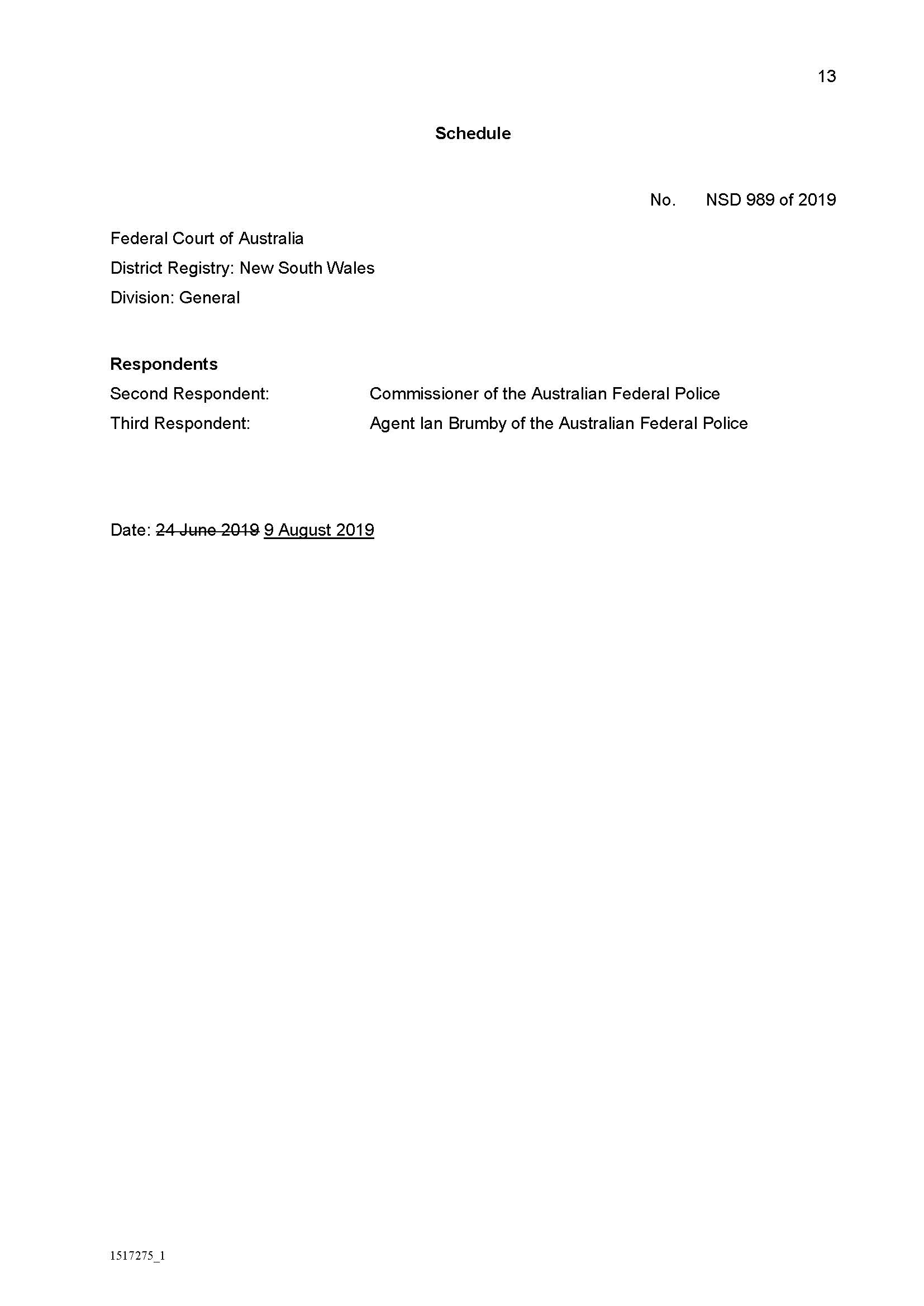
Annexure B
